Community Intervention Plan for Hypertension Prevention
VerifiedAdded on 2023/03/23
|26
|5828
|96
AI Summary
This document provides a community intervention plan for the prevention of hypertension. It includes information about the project officers, project partners, rationale, target group, goals and objectives, strategies, and evaluation. The plan aims to lower the rate of hypertension among Tasmanian men by implementing health empowerment programs.
Contribute Materials
Your contribution can guide someone’s learning journey. Share your
documents today.
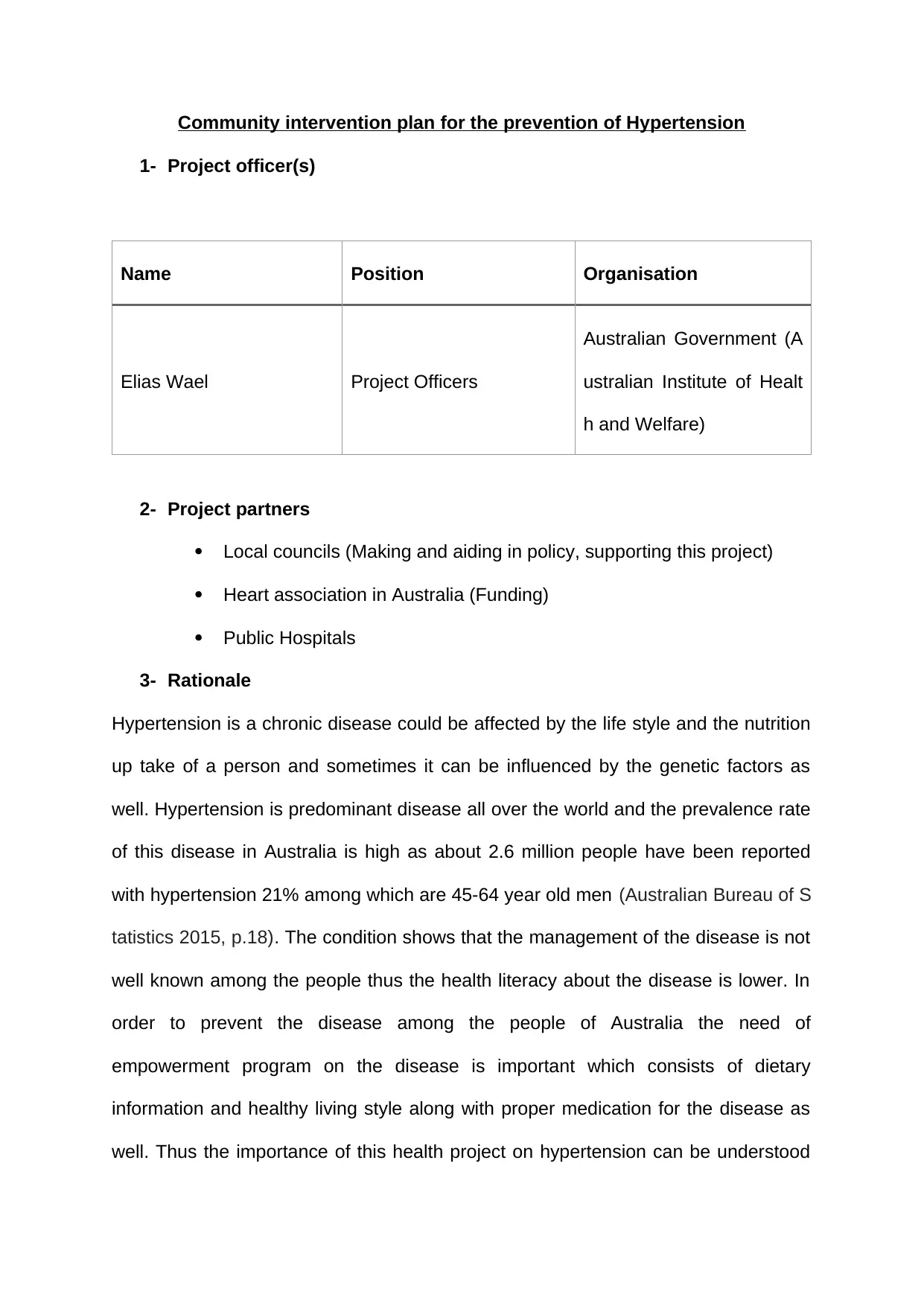
Community intervention plan for the prevention of Hypertension
1- Project officer(s)
Name Position Organisation
Elias Wael Project Officers
Australian Government (A
ustralian Institute of Healt
h and Welfare)
2- Project partners
Local councils (Making and aiding in policy, supporting this project)
Heart association in Australia (Funding)
Public Hospitals
3- Rationale
Hypertension is a chronic disease could be affected by the life style and the nutrition
up take of a person and sometimes it can be influenced by the genetic factors as
well. Hypertension is predominant disease all over the world and the prevalence rate
of this disease in Australia is high as about 2.6 million people have been reported
with hypertension 21% among which are 45-64 year old men (Australian Bureau of S
tatistics 2015, p.18). The condition shows that the management of the disease is not
well known among the people thus the health literacy about the disease is lower. In
order to prevent the disease among the people of Australia the need of
empowerment program on the disease is important which consists of dietary
information and healthy living style along with proper medication for the disease as
well. Thus the importance of this health project on hypertension can be understood
1- Project officer(s)
Name Position Organisation
Elias Wael Project Officers
Australian Government (A
ustralian Institute of Healt
h and Welfare)
2- Project partners
Local councils (Making and aiding in policy, supporting this project)
Heart association in Australia (Funding)
Public Hospitals
3- Rationale
Hypertension is a chronic disease could be affected by the life style and the nutrition
up take of a person and sometimes it can be influenced by the genetic factors as
well. Hypertension is predominant disease all over the world and the prevalence rate
of this disease in Australia is high as about 2.6 million people have been reported
with hypertension 21% among which are 45-64 year old men (Australian Bureau of S
tatistics 2015, p.18). The condition shows that the management of the disease is not
well known among the people thus the health literacy about the disease is lower. In
order to prevent the disease among the people of Australia the need of
empowerment program on the disease is important which consists of dietary
information and healthy living style along with proper medication for the disease as
well. Thus the importance of this health project on hypertension can be understood
Secure Best Marks with AI Grader
Need help grading? Try our AI Grader for instant feedback on your assignments.
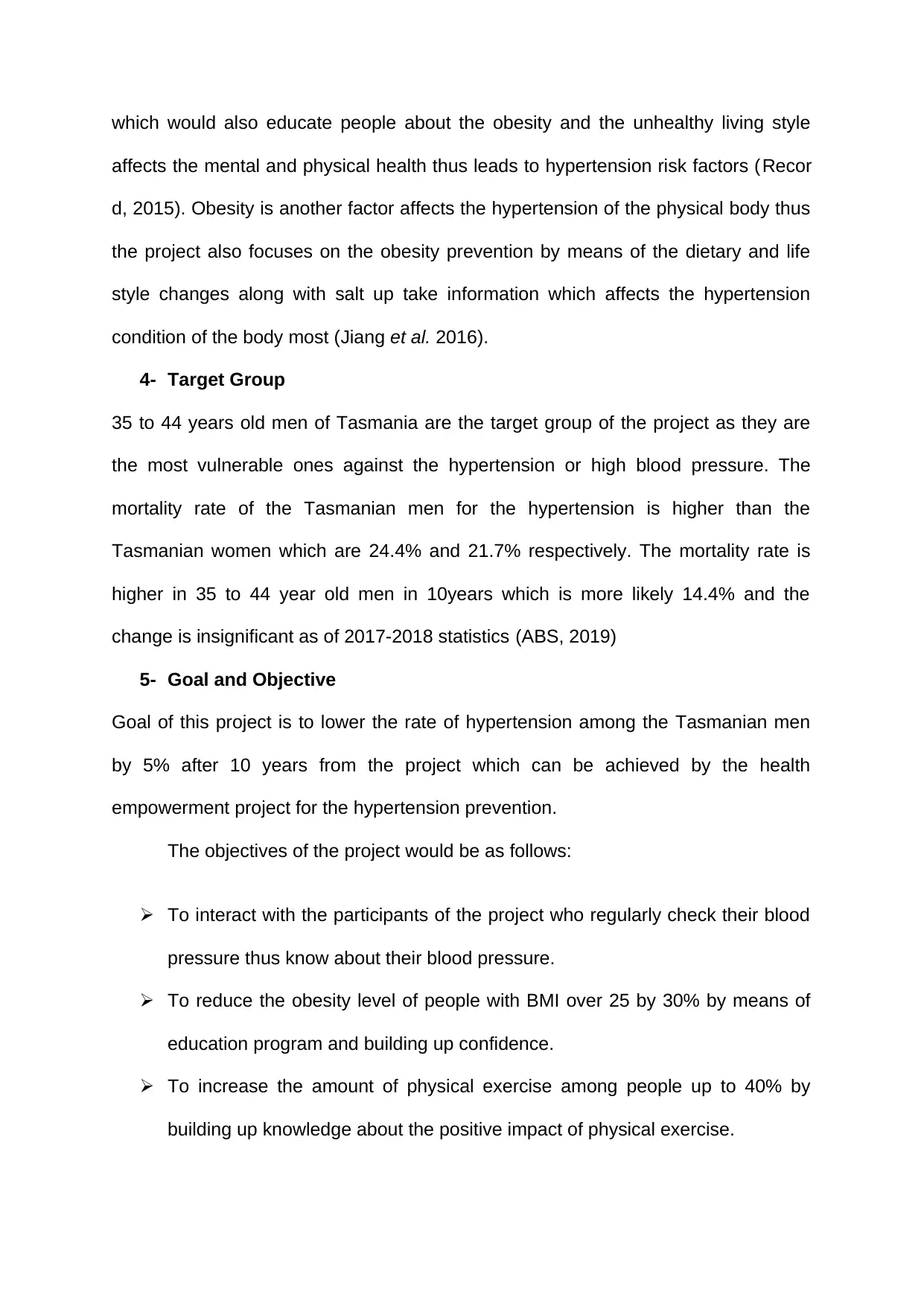
which would also educate people about the obesity and the unhealthy living style
affects the mental and physical health thus leads to hypertension risk factors (Recor
d, 2015). Obesity is another factor affects the hypertension of the physical body thus
the project also focuses on the obesity prevention by means of the dietary and life
style changes along with salt up take information which affects the hypertension
condition of the body most (Jiang et al. 2016).
4- Target Group
35 to 44 years old men of Tasmania are the target group of the project as they are
the most vulnerable ones against the hypertension or high blood pressure. The
mortality rate of the Tasmanian men for the hypertension is higher than the
Tasmanian women which are 24.4% and 21.7% respectively. The mortality rate is
higher in 35 to 44 year old men in 10years which is more likely 14.4% and the
change is insignificant as of 2017-2018 statistics (ABS, 2019)
5- Goal and Objective
Goal of this project is to lower the rate of hypertension among the Tasmanian men
by 5% after 10 years from the project which can be achieved by the health
empowerment project for the hypertension prevention.
The objectives of the project would be as follows:
To interact with the participants of the project who regularly check their blood
pressure thus know about their blood pressure.
To reduce the obesity level of people with BMI over 25 by 30% by means of
education program and building up confidence.
To increase the amount of physical exercise among people up to 40% by
building up knowledge about the positive impact of physical exercise.
affects the mental and physical health thus leads to hypertension risk factors (Recor
d, 2015). Obesity is another factor affects the hypertension of the physical body thus
the project also focuses on the obesity prevention by means of the dietary and life
style changes along with salt up take information which affects the hypertension
condition of the body most (Jiang et al. 2016).
4- Target Group
35 to 44 years old men of Tasmania are the target group of the project as they are
the most vulnerable ones against the hypertension or high blood pressure. The
mortality rate of the Tasmanian men for the hypertension is higher than the
Tasmanian women which are 24.4% and 21.7% respectively. The mortality rate is
higher in 35 to 44 year old men in 10years which is more likely 14.4% and the
change is insignificant as of 2017-2018 statistics (ABS, 2019)
5- Goal and Objective
Goal of this project is to lower the rate of hypertension among the Tasmanian men
by 5% after 10 years from the project which can be achieved by the health
empowerment project for the hypertension prevention.
The objectives of the project would be as follows:
To interact with the participants of the project who regularly check their blood
pressure thus know about their blood pressure.
To reduce the obesity level of people with BMI over 25 by 30% by means of
education program and building up confidence.
To increase the amount of physical exercise among people up to 40% by
building up knowledge about the positive impact of physical exercise.
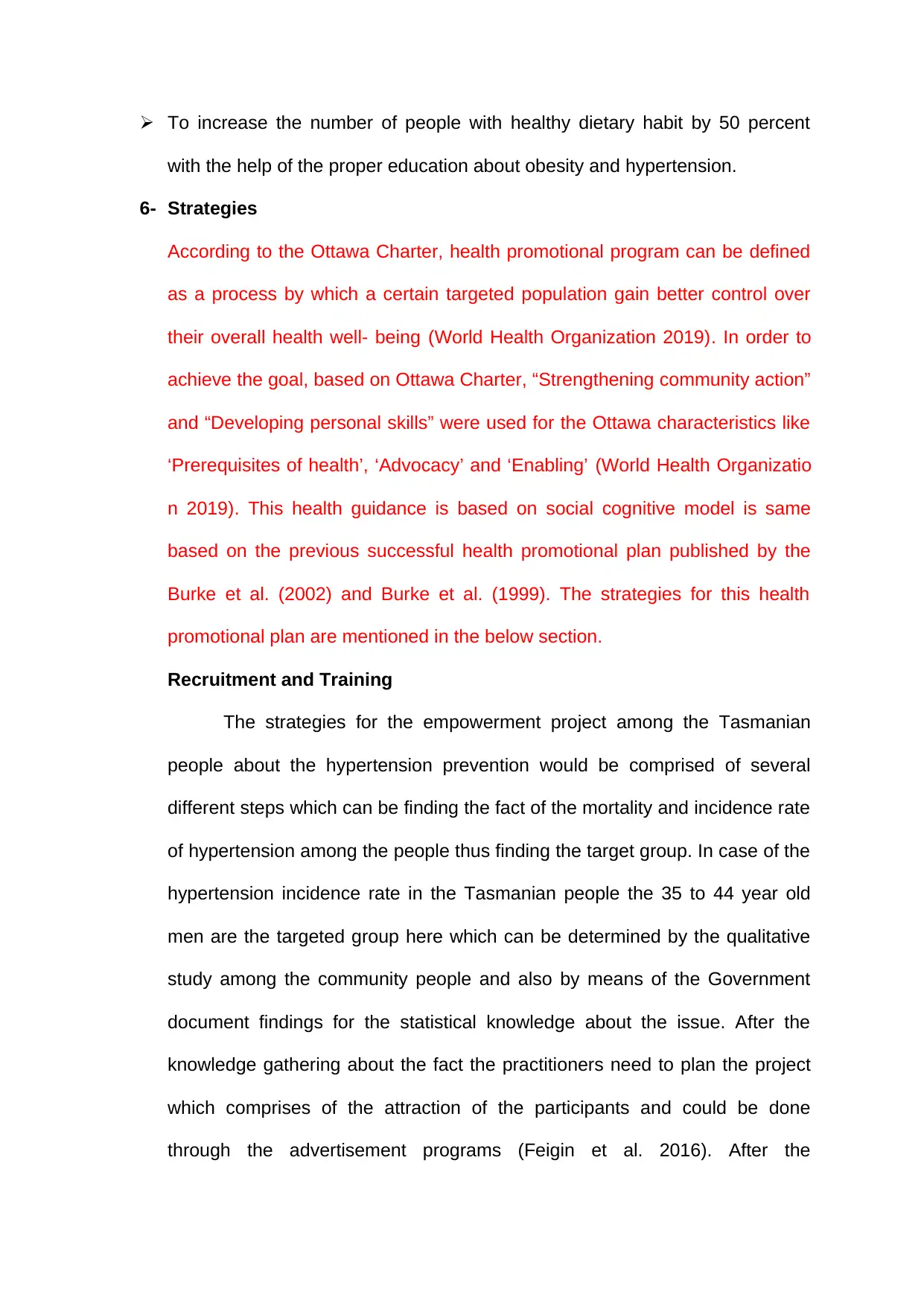
To increase the number of people with healthy dietary habit by 50 percent
with the help of the proper education about obesity and hypertension.
6- Strategies
According to the Ottawa Charter, health promotional program can be defined
as a process by which a certain targeted population gain better control over
their overall health well- being (World Health Organization 2019). In order to
achieve the goal, based on Ottawa Charter, “Strengthening community action”
and “Developing personal skills” were used for the Ottawa characteristics like
‘Prerequisites of health’, ‘Advocacy’ and ‘Enabling’ (World Health Organizatio
n 2019). This health guidance is based on social cognitive model is same
based on the previous successful health promotional plan published by the
Burke et al. (2002) and Burke et al. (1999). The strategies for this health
promotional plan are mentioned in the below section.
Recruitment and Training
The strategies for the empowerment project among the Tasmanian
people about the hypertension prevention would be comprised of several
different steps which can be finding the fact of the mortality and incidence rate
of hypertension among the people thus finding the target group. In case of the
hypertension incidence rate in the Tasmanian people the 35 to 44 year old
men are the targeted group here which can be determined by the qualitative
study among the community people and also by means of the Government
document findings for the statistical knowledge about the issue. After the
knowledge gathering about the fact the practitioners need to plan the project
which comprises of the attraction of the participants and could be done
through the advertisement programs (Feigin et al. 2016). After the
with the help of the proper education about obesity and hypertension.
6- Strategies
According to the Ottawa Charter, health promotional program can be defined
as a process by which a certain targeted population gain better control over
their overall health well- being (World Health Organization 2019). In order to
achieve the goal, based on Ottawa Charter, “Strengthening community action”
and “Developing personal skills” were used for the Ottawa characteristics like
‘Prerequisites of health’, ‘Advocacy’ and ‘Enabling’ (World Health Organizatio
n 2019). This health guidance is based on social cognitive model is same
based on the previous successful health promotional plan published by the
Burke et al. (2002) and Burke et al. (1999). The strategies for this health
promotional plan are mentioned in the below section.
Recruitment and Training
The strategies for the empowerment project among the Tasmanian
people about the hypertension prevention would be comprised of several
different steps which can be finding the fact of the mortality and incidence rate
of hypertension among the people thus finding the target group. In case of the
hypertension incidence rate in the Tasmanian people the 35 to 44 year old
men are the targeted group here which can be determined by the qualitative
study among the community people and also by means of the Government
document findings for the statistical knowledge about the issue. After the
knowledge gathering about the fact the practitioners need to plan the project
which comprises of the attraction of the participants and could be done
through the advertisement programs (Feigin et al. 2016). After the

advertisement program the participants of the project would be selected or
recruited on the basis of the age and the health condition that is the obesity
affected people and subsequently hypertension patients. In order to precede
with the project the consultation letter would be created which would be
comprised of the consent of the participants about their willingness to
participate in the project and the permission of Government also would be
incorporated in this consultation letter (Olsen et al. 2016).
After these primary stages the strategy of the project can be properly
implemented that is the training and check- up of the participants as well as
other stakeholders of the project. Here the stakeholders are the nurses,
dieticians, local Government and most importantly the participants with
hypertension and obesity. The training process of the nurses or the dieticians
would comprise of the proper nutrition and healthy diet that can effectively
impact on the hypertension and obese condition of the participants and the
nutrition and the diet would be independent of age of the patients. The next
phase would be the training of the participants in different locality by these
trained nurses, dieticians and social workers and volunteers. The training for
the participants would be comprised of the healthy living practices such as the
daily exercises, proper low calorie diet which would be without improper
sodium balance, proper diet for controlling the hypertension (Hall et al. 2015).
Check up
The strategic part of the project comprised of the check- up process of
the participants as well in which the participants would be checked up on the
basis of their high blood pressure level or blood pressure level and the risk
factors of the disease would be taught to those participants and thus reducing
recruited on the basis of the age and the health condition that is the obesity
affected people and subsequently hypertension patients. In order to precede
with the project the consultation letter would be created which would be
comprised of the consent of the participants about their willingness to
participate in the project and the permission of Government also would be
incorporated in this consultation letter (Olsen et al. 2016).
After these primary stages the strategy of the project can be properly
implemented that is the training and check- up of the participants as well as
other stakeholders of the project. Here the stakeholders are the nurses,
dieticians, local Government and most importantly the participants with
hypertension and obesity. The training process of the nurses or the dieticians
would comprise of the proper nutrition and healthy diet that can effectively
impact on the hypertension and obese condition of the participants and the
nutrition and the diet would be independent of age of the patients. The next
phase would be the training of the participants in different locality by these
trained nurses, dieticians and social workers and volunteers. The training for
the participants would be comprised of the healthy living practices such as the
daily exercises, proper low calorie diet which would be without improper
sodium balance, proper diet for controlling the hypertension (Hall et al. 2015).
Check up
The strategic part of the project comprised of the check- up process of
the participants as well in which the participants would be checked up on the
basis of their high blood pressure level or blood pressure level and the risk
factors of the disease would be taught to those participants and thus reducing
Paraphrase This Document
Need a fresh take? Get an instant paraphrase of this document with our AI Paraphraser

them by empowering about the factors of the disease or the effects of the
disease on the body along with the knowledge of the prevention process such
as daily exercise, low calorie and low sodium content diet. All these factors
would be helpful in the awareness for the participants of the risk group that is
the 35 to 44 year old men of Tasmania (McElfish et al. 2017).
This check- up and awareness process would also be comprised of the
comparison of data of the previous programs on hypertension conducted in
Australia and the data found in this project. On the basis of this comparison
measure the nutrition education would be done as the changes needed from
the before check- up and training would be evaluated on the basis of the
comparison process. The awareness about the daily lifestyle and the
nutritional education would be solely dependent on the factor of the
comparison and the present data found among the targeted group (Burks,
Stickel and Galie, 2018).
The individual check- up process would be dependent on the nurses
and the physicians of the project and the blood pressure of the participants
would be the factor that determines the further need of the awareness for the
participants. The check- up of the individuals would be done very carefully for
the proper assessment of the blood pressure level of the participants whether
it crosses the borderline or the blood pressure is lower than the borderline,
that is the factor needed to be observed and calculated. The borderline of the
blood pressure level among the 35 to 44 year olds is in case of systolic 130-
139 mmHg and in case of diastolic it is 85-89 mmHg. The number of
participants with higher amount than the borderline of blood pressure level
and the participants with lower amount of blood pressure level than the
disease on the body along with the knowledge of the prevention process such
as daily exercise, low calorie and low sodium content diet. All these factors
would be helpful in the awareness for the participants of the risk group that is
the 35 to 44 year old men of Tasmania (McElfish et al. 2017).
This check- up and awareness process would also be comprised of the
comparison of data of the previous programs on hypertension conducted in
Australia and the data found in this project. On the basis of this comparison
measure the nutrition education would be done as the changes needed from
the before check- up and training would be evaluated on the basis of the
comparison process. The awareness about the daily lifestyle and the
nutritional education would be solely dependent on the factor of the
comparison and the present data found among the targeted group (Burks,
Stickel and Galie, 2018).
The individual check- up process would be dependent on the nurses
and the physicians of the project and the blood pressure of the participants
would be the factor that determines the further need of the awareness for the
participants. The check- up of the individuals would be done very carefully for
the proper assessment of the blood pressure level of the participants whether
it crosses the borderline or the blood pressure is lower than the borderline,
that is the factor needed to be observed and calculated. The borderline of the
blood pressure level among the 35 to 44 year olds is in case of systolic 130-
139 mmHg and in case of diastolic it is 85-89 mmHg. The number of
participants with higher amount than the borderline of blood pressure level
and the participants with lower amount of blood pressure level than the

borderline would be assessed as well in order to find out the condition or the
statistics of the hypertension among the people in present condition
(Daskalopoulou et al. 2015).
The nurses in this project would be the person who is responsible for
the blood pressure measurement and the process would be conducted with
the help of the mercury sphygmomanometer. People with 130 to 139 mmHg
systolic pressure and 85 to 89 mmHg diastolic pressures or higher than these
marks would be placed under the nutrition education group and the people
under these marks would be placed in the group of risk less people. However,
the education process would be delivered to all the people with emphasis on
the affected group (Franklin et al. 2015).
Table 1: Classification of blood pressure
Classification Systolic (mmH
g)
Diastolic (mmH
g)
Optimal < 120 and <80
Normal 120-129 and/or 80-84
High normal 130-139 and/or 85-89
Grade 1 (mil
d) hypertensi
on
140-159 and/or 90-99
Grade 2 (mod
erate) hypert
160-179 and/or 100-109
statistics of the hypertension among the people in present condition
(Daskalopoulou et al. 2015).
The nurses in this project would be the person who is responsible for
the blood pressure measurement and the process would be conducted with
the help of the mercury sphygmomanometer. People with 130 to 139 mmHg
systolic pressure and 85 to 89 mmHg diastolic pressures or higher than these
marks would be placed under the nutrition education group and the people
under these marks would be placed in the group of risk less people. However,
the education process would be delivered to all the people with emphasis on
the affected group (Franklin et al. 2015).
Table 1: Classification of blood pressure
Classification Systolic (mmH
g)
Diastolic (mmH
g)
Optimal < 120 and <80
Normal 120-129 and/or 80-84
High normal 130-139 and/or 85-89
Grade 1 (mil
d) hypertensi
on
140-159 and/or 90-99
Grade 2 (mod
erate) hypert
160-179 and/or 100-109
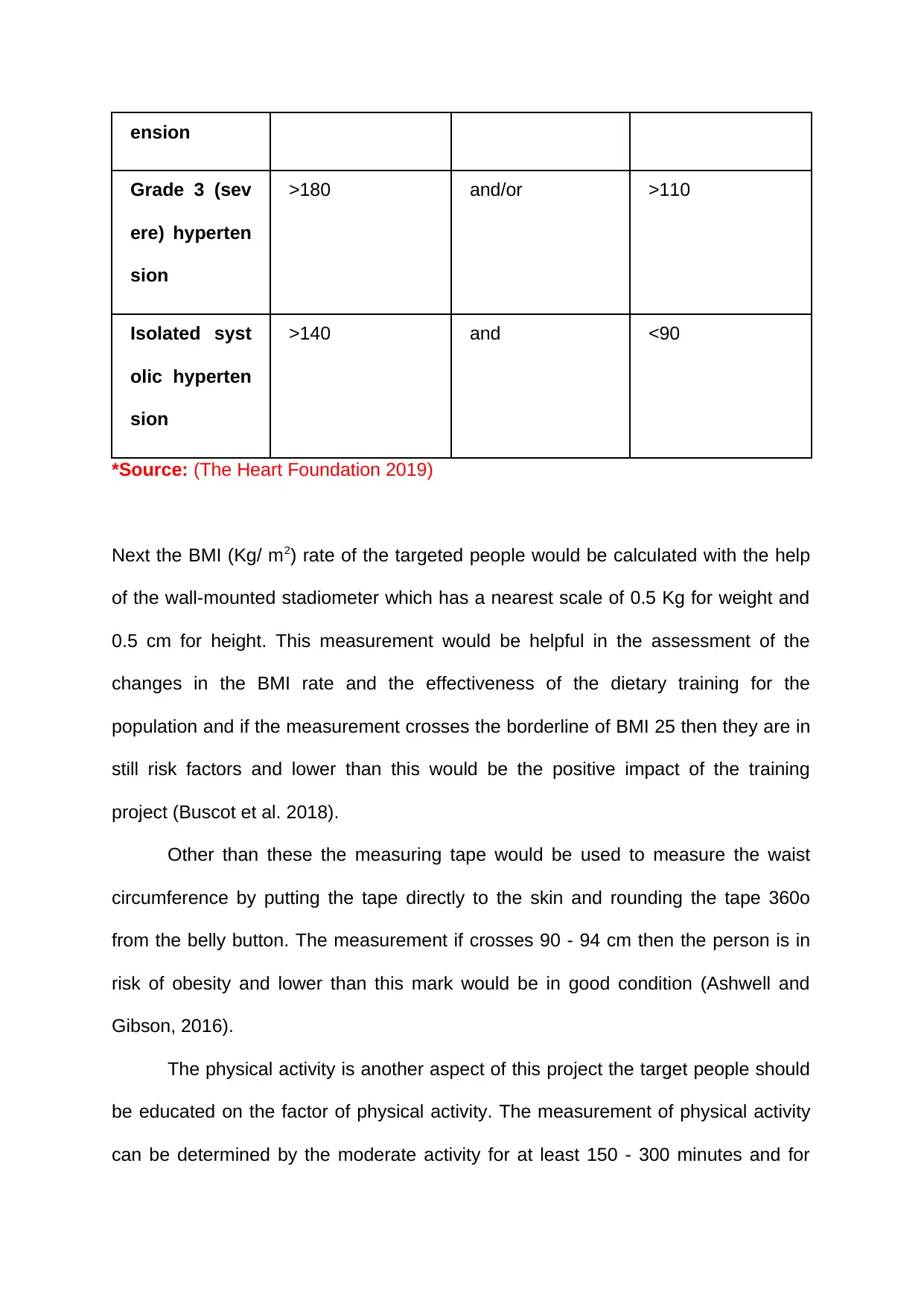
ension
Grade 3 (sev
ere) hyperten
sion
>180 and/or >110
Isolated syst
olic hyperten
sion
>140 and <90
*Source: (The Heart Foundation 2019)
Next the BMI (Kg/ m2) rate of the targeted people would be calculated with the help
of the wall-mounted stadiometer which has a nearest scale of 0.5 Kg for weight and
0.5 cm for height. This measurement would be helpful in the assessment of the
changes in the BMI rate and the effectiveness of the dietary training for the
population and if the measurement crosses the borderline of BMI 25 then they are in
still risk factors and lower than this would be the positive impact of the training
project (Buscot et al. 2018).
Other than these the measuring tape would be used to measure the waist
circumference by putting the tape directly to the skin and rounding the tape 360o
from the belly button. The measurement if crosses 90 - 94 cm then the person is in
risk of obesity and lower than this mark would be in good condition (Ashwell and
Gibson, 2016).
The physical activity is another aspect of this project the target people should
be educated on the factor of physical activity. The measurement of physical activity
can be determined by the moderate activity for at least 150 - 300 minutes and for
Grade 3 (sev
ere) hyperten
sion
>180 and/or >110
Isolated syst
olic hyperten
sion
>140 and <90
*Source: (The Heart Foundation 2019)
Next the BMI (Kg/ m2) rate of the targeted people would be calculated with the help
of the wall-mounted stadiometer which has a nearest scale of 0.5 Kg for weight and
0.5 cm for height. This measurement would be helpful in the assessment of the
changes in the BMI rate and the effectiveness of the dietary training for the
population and if the measurement crosses the borderline of BMI 25 then they are in
still risk factors and lower than this would be the positive impact of the training
project (Buscot et al. 2018).
Other than these the measuring tape would be used to measure the waist
circumference by putting the tape directly to the skin and rounding the tape 360o
from the belly button. The measurement if crosses 90 - 94 cm then the person is in
risk of obesity and lower than this mark would be in good condition (Ashwell and
Gibson, 2016).
The physical activity is another aspect of this project the target people should
be educated on the factor of physical activity. The measurement of physical activity
can be determined by the moderate activity for at least 150 - 300 minutes and for
Secure Best Marks with AI Grader
Need help grading? Try our AI Grader for instant feedback on your assignments.

intensive activity 75 - 150 minutes would be sufficient for one person with obesity or
the combined activity would also help in a better way. However, muscle stretching
activities should be taken in account for at least 2 days a week. On the other hand
the dietary intake should be evaluated on the basis of the intake of 5 serve size
vegetable and 2 serve size fruit every day. The salt intake on the other hand needs
to be lower than 6g per day in case of the primary prevention and in case of the
secondary it will be 4g maximum per day (Liu et al. 2017).
The medication history of the people would also be a critical factor as the
people taking medication would not need any dietary prevention and the medication
would be comprised of ACE inhibitors, diuretics, Angiostenin II receptor blockers and
others (Vrijens et al.2017).
Providing information
The project is more of the providing information about the high blood pressure
that is the empowerment for the people with hypertension risk factor about the
disease. In order to provide information distribution of leaflet or email the
advertisement would be used in order to attract the target persons towards the
project. The project would also be comprised of providing information about the risk
factors and the effects of the high blood pressure. The health guidance would be
comprised of physical activity, nutrition chart and incidental activity which can be
received by the participants over the mail or in contact with the facilitators of the
project every 2 week. The aim of the module is to demonstrate exercise techniques,
question answers and review the changes among the target people (Coca et al.
2017). The module helps in the self-directed change in behaviour for the participants;
impacting the life style and help them follow a healthy living process and also the risk
factors of the hypertension along with obesity. The nodule would also focus on the
the combined activity would also help in a better way. However, muscle stretching
activities should be taken in account for at least 2 days a week. On the other hand
the dietary intake should be evaluated on the basis of the intake of 5 serve size
vegetable and 2 serve size fruit every day. The salt intake on the other hand needs
to be lower than 6g per day in case of the primary prevention and in case of the
secondary it will be 4g maximum per day (Liu et al. 2017).
The medication history of the people would also be a critical factor as the
people taking medication would not need any dietary prevention and the medication
would be comprised of ACE inhibitors, diuretics, Angiostenin II receptor blockers and
others (Vrijens et al.2017).
Providing information
The project is more of the providing information about the high blood pressure
that is the empowerment for the people with hypertension risk factor about the
disease. In order to provide information distribution of leaflet or email the
advertisement would be used in order to attract the target persons towards the
project. The project would also be comprised of providing information about the risk
factors and the effects of the high blood pressure. The health guidance would be
comprised of physical activity, nutrition chart and incidental activity which can be
received by the participants over the mail or in contact with the facilitators of the
project every 2 week. The aim of the module is to demonstrate exercise techniques,
question answers and review the changes among the target people (Coca et al.
2017). The module helps in the self-directed change in behaviour for the participants;
impacting the life style and help them follow a healthy living process and also the risk
factors of the hypertension along with obesity. The nodule would also focus on the
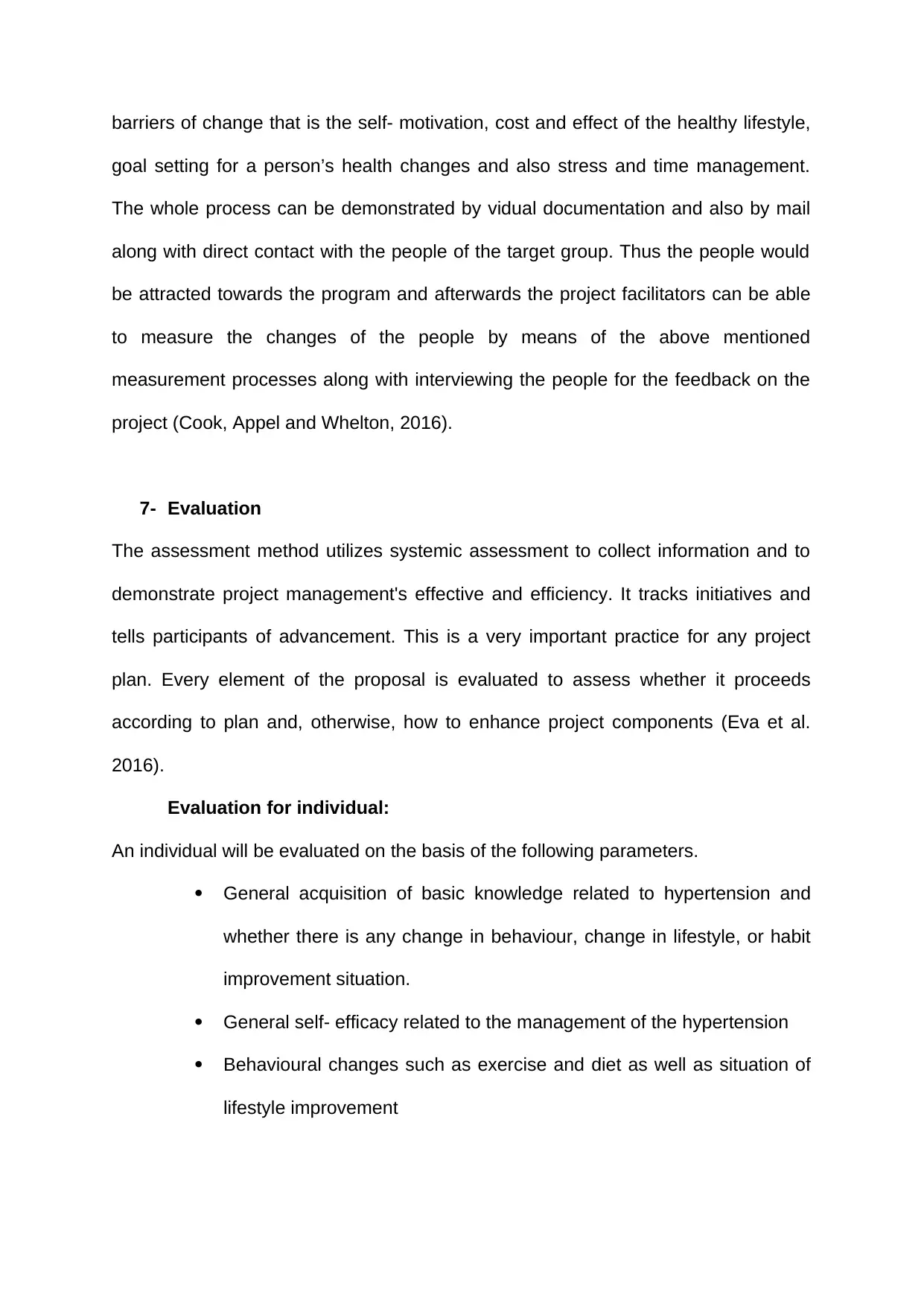
barriers of change that is the self- motivation, cost and effect of the healthy lifestyle,
goal setting for a person’s health changes and also stress and time management.
The whole process can be demonstrated by vidual documentation and also by mail
along with direct contact with the people of the target group. Thus the people would
be attracted towards the program and afterwards the project facilitators can be able
to measure the changes of the people by means of the above mentioned
measurement processes along with interviewing the people for the feedback on the
project (Cook, Appel and Whelton, 2016).
7- Evaluation
The assessment method utilizes systemic assessment to collect information and to
demonstrate project management's effective and efficiency. It tracks initiatives and
tells participants of advancement. This is a very important practice for any project
plan. Every element of the proposal is evaluated to assess whether it proceeds
according to plan and, otherwise, how to enhance project components (Eva et al.
2016).
Evaluation for individual:
An individual will be evaluated on the basis of the following parameters.
General acquisition of basic knowledge related to hypertension and
whether there is any change in behaviour, change in lifestyle, or habit
improvement situation.
General self- efficacy related to the management of the hypertension
Behavioural changes such as exercise and diet as well as situation of
lifestyle improvement
goal setting for a person’s health changes and also stress and time management.
The whole process can be demonstrated by vidual documentation and also by mail
along with direct contact with the people of the target group. Thus the people would
be attracted towards the program and afterwards the project facilitators can be able
to measure the changes of the people by means of the above mentioned
measurement processes along with interviewing the people for the feedback on the
project (Cook, Appel and Whelton, 2016).
7- Evaluation
The assessment method utilizes systemic assessment to collect information and to
demonstrate project management's effective and efficiency. It tracks initiatives and
tells participants of advancement. This is a very important practice for any project
plan. Every element of the proposal is evaluated to assess whether it proceeds
according to plan and, otherwise, how to enhance project components (Eva et al.
2016).
Evaluation for individual:
An individual will be evaluated on the basis of the following parameters.
General acquisition of basic knowledge related to hypertension and
whether there is any change in behaviour, change in lifestyle, or habit
improvement situation.
General self- efficacy related to the management of the hypertension
Behavioural changes such as exercise and diet as well as situation of
lifestyle improvement
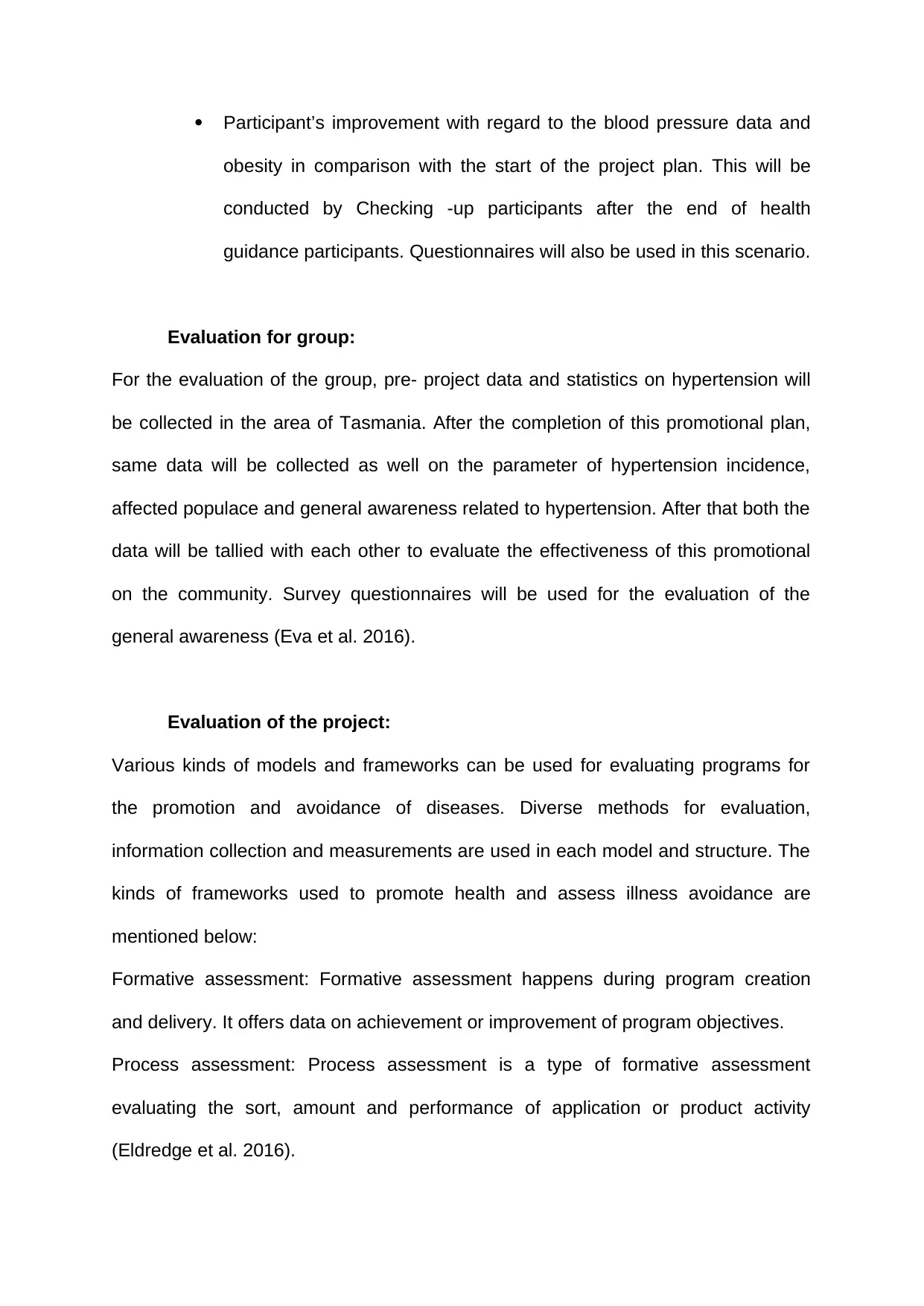
Participant’s improvement with regard to the blood pressure data and
obesity in comparison with the start of the project plan. This will be
conducted by Checking -up participants after the end of health
guidance participants. Questionnaires will also be used in this scenario.
Evaluation for group:
For the evaluation of the group, pre- project data and statistics on hypertension will
be collected in the area of Tasmania. After the completion of this promotional plan,
same data will be collected as well on the parameter of hypertension incidence,
affected populace and general awareness related to hypertension. After that both the
data will be tallied with each other to evaluate the effectiveness of this promotional
on the community. Survey questionnaires will be used for the evaluation of the
general awareness (Eva et al. 2016).
Evaluation of the project:
Various kinds of models and frameworks can be used for evaluating programs for
the promotion and avoidance of diseases. Diverse methods for evaluation,
information collection and measurements are used in each model and structure. The
kinds of frameworks used to promote health and assess illness avoidance are
mentioned below:
Formative assessment: Formative assessment happens during program creation
and delivery. It offers data on achievement or improvement of program objectives.
Process assessment: Process assessment is a type of formative assessment
evaluating the sort, amount and performance of application or product activity
(Eldredge et al. 2016).
obesity in comparison with the start of the project plan. This will be
conducted by Checking -up participants after the end of health
guidance participants. Questionnaires will also be used in this scenario.
Evaluation for group:
For the evaluation of the group, pre- project data and statistics on hypertension will
be collected in the area of Tasmania. After the completion of this promotional plan,
same data will be collected as well on the parameter of hypertension incidence,
affected populace and general awareness related to hypertension. After that both the
data will be tallied with each other to evaluate the effectiveness of this promotional
on the community. Survey questionnaires will be used for the evaluation of the
general awareness (Eva et al. 2016).
Evaluation of the project:
Various kinds of models and frameworks can be used for evaluating programs for
the promotion and avoidance of diseases. Diverse methods for evaluation,
information collection and measurements are used in each model and structure. The
kinds of frameworks used to promote health and assess illness avoidance are
mentioned below:
Formative assessment: Formative assessment happens during program creation
and delivery. It offers data on achievement or improvement of program objectives.
Process assessment: Process assessment is a type of formative assessment
evaluating the sort, amount and performance of application or product activity
(Eldredge et al. 2016).
Paraphrase This Document
Need a fresh take? Get an instant paraphrase of this document with our AI Paraphraser
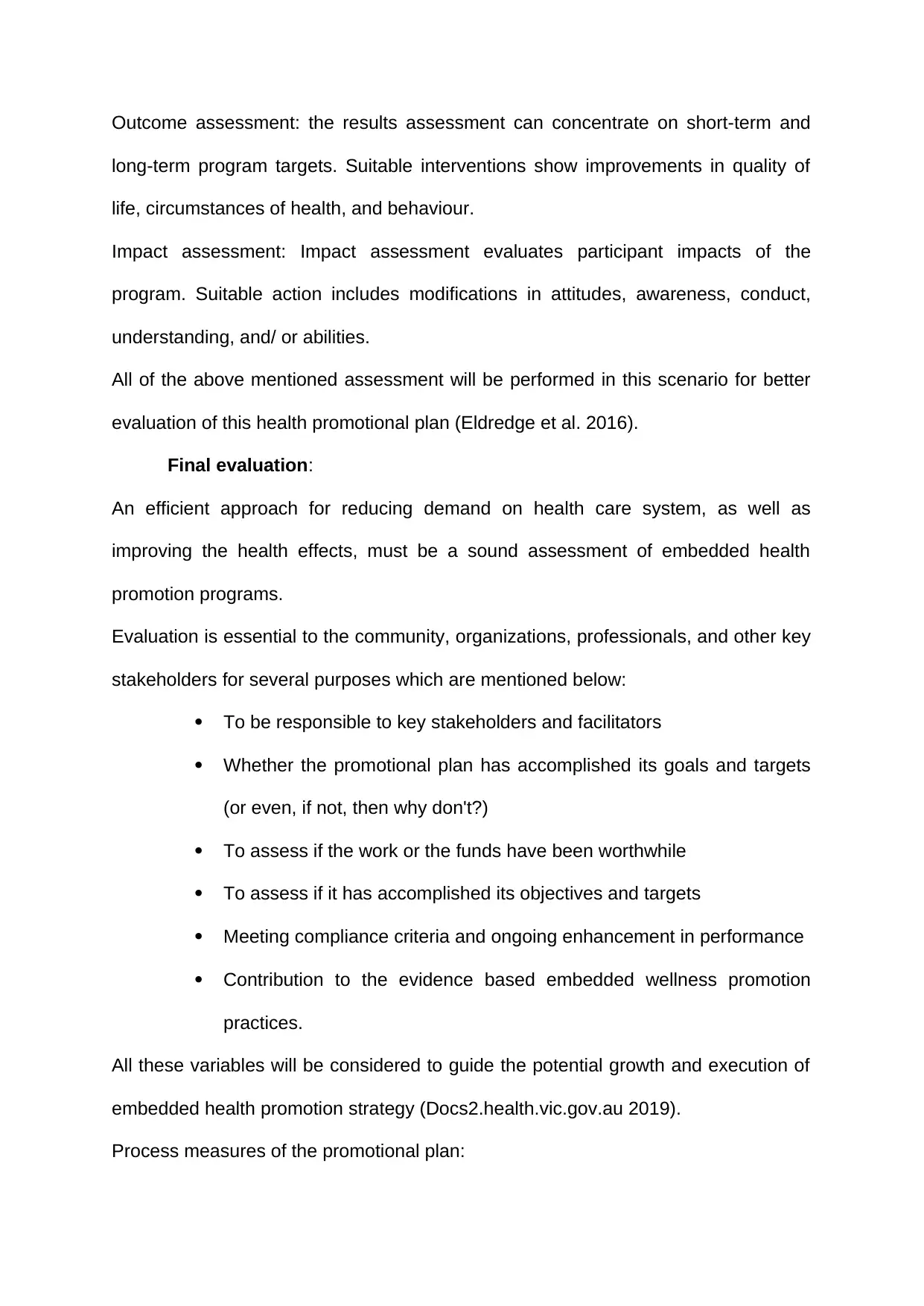
Outcome assessment: the results assessment can concentrate on short-term and
long-term program targets. Suitable interventions show improvements in quality of
life, circumstances of health, and behaviour.
Impact assessment: Impact assessment evaluates participant impacts of the
program. Suitable action includes modifications in attitudes, awareness, conduct,
understanding, and/ or abilities.
All of the above mentioned assessment will be performed in this scenario for better
evaluation of this health promotional plan (Eldredge et al. 2016).
Final evaluation:
An efficient approach for reducing demand on health care system, as well as
improving the health effects, must be a sound assessment of embedded health
promotion programs.
Evaluation is essential to the community, organizations, professionals, and other key
stakeholders for several purposes which are mentioned below:
To be responsible to key stakeholders and facilitators
Whether the promotional plan has accomplished its goals and targets
(or even, if not, then why don't?)
To assess if the work or the funds have been worthwhile
To assess if it has accomplished its objectives and targets
Meeting compliance criteria and ongoing enhancement in performance
Contribution to the evidence based embedded wellness promotion
practices.
All these variables will be considered to guide the potential growth and execution of
embedded health promotion strategy (Docs2.health.vic.gov.au 2019).
Process measures of the promotional plan:
long-term program targets. Suitable interventions show improvements in quality of
life, circumstances of health, and behaviour.
Impact assessment: Impact assessment evaluates participant impacts of the
program. Suitable action includes modifications in attitudes, awareness, conduct,
understanding, and/ or abilities.
All of the above mentioned assessment will be performed in this scenario for better
evaluation of this health promotional plan (Eldredge et al. 2016).
Final evaluation:
An efficient approach for reducing demand on health care system, as well as
improving the health effects, must be a sound assessment of embedded health
promotion programs.
Evaluation is essential to the community, organizations, professionals, and other key
stakeholders for several purposes which are mentioned below:
To be responsible to key stakeholders and facilitators
Whether the promotional plan has accomplished its goals and targets
(or even, if not, then why don't?)
To assess if the work or the funds have been worthwhile
To assess if it has accomplished its objectives and targets
Meeting compliance criteria and ongoing enhancement in performance
Contribution to the evidence based embedded wellness promotion
practices.
All these variables will be considered to guide the potential growth and execution of
embedded health promotion strategy (Docs2.health.vic.gov.au 2019).
Process measures of the promotional plan:
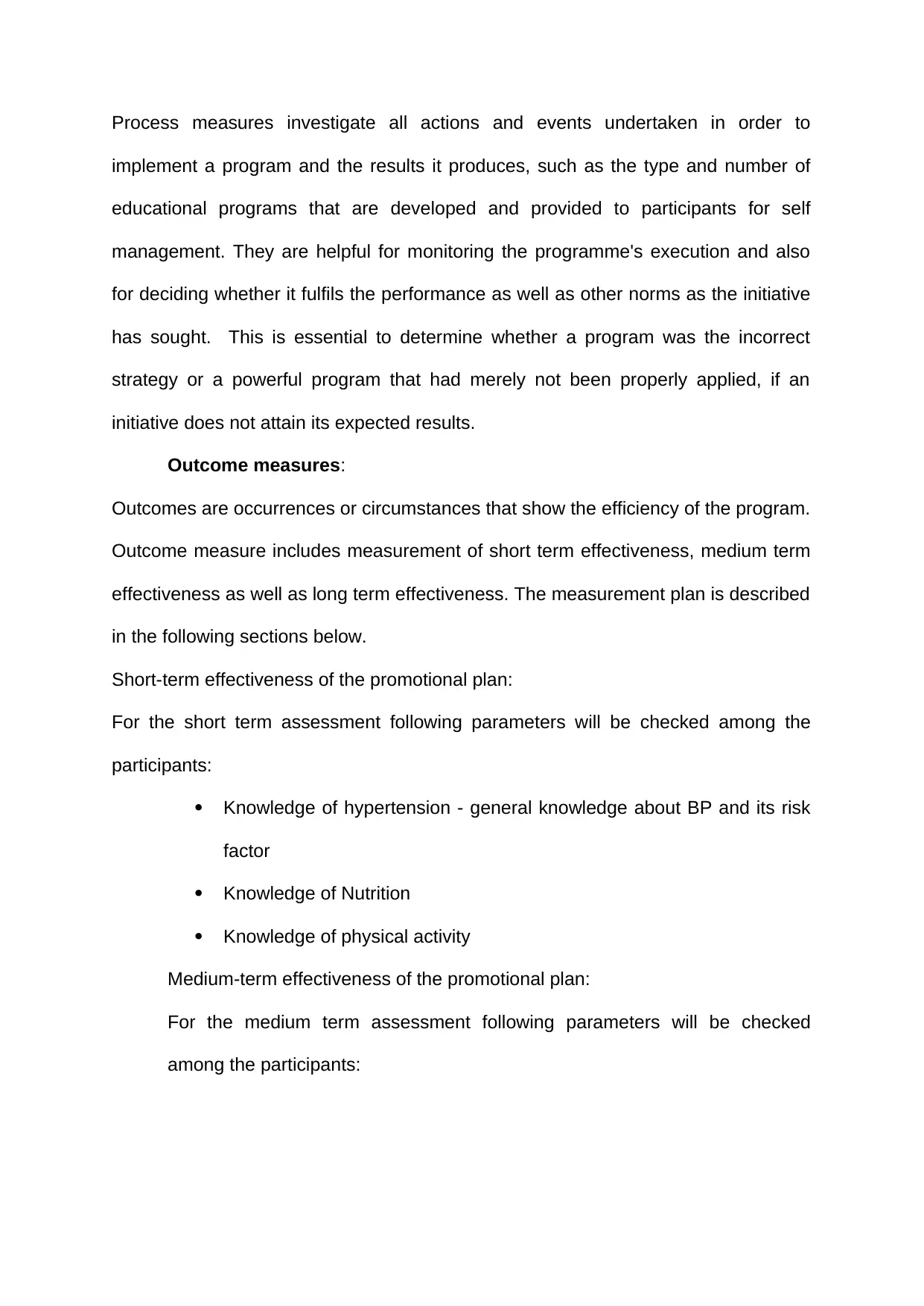
Process measures investigate all actions and events undertaken in order to
implement a program and the results it produces, such as the type and number of
educational programs that are developed and provided to participants for self
management. They are helpful for monitoring the programme's execution and also
for deciding whether it fulfils the performance as well as other norms as the initiative
has sought. This is essential to determine whether a program was the incorrect
strategy or a powerful program that had merely not been properly applied, if an
initiative does not attain its expected results.
Outcome measures:
Outcomes are occurrences or circumstances that show the efficiency of the program.
Outcome measure includes measurement of short term effectiveness, medium term
effectiveness as well as long term effectiveness. The measurement plan is described
in the following sections below.
Short-term effectiveness of the promotional plan:
For the short term assessment following parameters will be checked among the
participants:
Knowledge of hypertension - general knowledge about BP and its risk
factor
Knowledge of Nutrition
Knowledge of physical activity
Medium-term effectiveness of the promotional plan:
For the medium term assessment following parameters will be checked
among the participants:
implement a program and the results it produces, such as the type and number of
educational programs that are developed and provided to participants for self
management. They are helpful for monitoring the programme's execution and also
for deciding whether it fulfils the performance as well as other norms as the initiative
has sought. This is essential to determine whether a program was the incorrect
strategy or a powerful program that had merely not been properly applied, if an
initiative does not attain its expected results.
Outcome measures:
Outcomes are occurrences or circumstances that show the efficiency of the program.
Outcome measure includes measurement of short term effectiveness, medium term
effectiveness as well as long term effectiveness. The measurement plan is described
in the following sections below.
Short-term effectiveness of the promotional plan:
For the short term assessment following parameters will be checked among the
participants:
Knowledge of hypertension - general knowledge about BP and its risk
factor
Knowledge of Nutrition
Knowledge of physical activity
Medium-term effectiveness of the promotional plan:
For the medium term assessment following parameters will be checked
among the participants:

State of Overweight or Obese - percentage of obesity has been
reduced among participants/do participants meet the normal range of
BMI
State of physical activity – whether the participants meet the borderline
of weekly exercise
State of eating habit- whether the participants eating habits have
changed or not
Long- term effectiveness of the promotional plan:
For the long term assessment following parameters will be checked among
the participants:
The improvement effect of hypertension - whether this promotional plan
managed to reduce 5 per cent of people with high blood pressure
decreased among Tasmanian men. Additionally, if it does not happen,
an investigation will be conducted why it does not happen to the
population and whether the promotional plan was effective or not.
8- Timeline
The total duration of this project plan is for one year. This promotional plan will be
completed in three phases. First phase will be run for 1 year and the second
phase will be run for the next ten years. Finally, the third phase will be completed
in after the completion of the second phase. The detailed timeline for this project
has been presented in the ‘Appendix – 1’ section later.
9- Resource and Budget
reduced among participants/do participants meet the normal range of
BMI
State of physical activity – whether the participants meet the borderline
of weekly exercise
State of eating habit- whether the participants eating habits have
changed or not
Long- term effectiveness of the promotional plan:
For the long term assessment following parameters will be checked among
the participants:
The improvement effect of hypertension - whether this promotional plan
managed to reduce 5 per cent of people with high blood pressure
decreased among Tasmanian men. Additionally, if it does not happen,
an investigation will be conducted why it does not happen to the
population and whether the promotional plan was effective or not.
8- Timeline
The total duration of this project plan is for one year. This promotional plan will be
completed in three phases. First phase will be run for 1 year and the second
phase will be run for the next ten years. Finally, the third phase will be completed
in after the completion of the second phase. The detailed timeline for this project
has been presented in the ‘Appendix – 1’ section later.
9- Resource and Budget
Secure Best Marks with AI Grader
Need help grading? Try our AI Grader for instant feedback on your assignments.
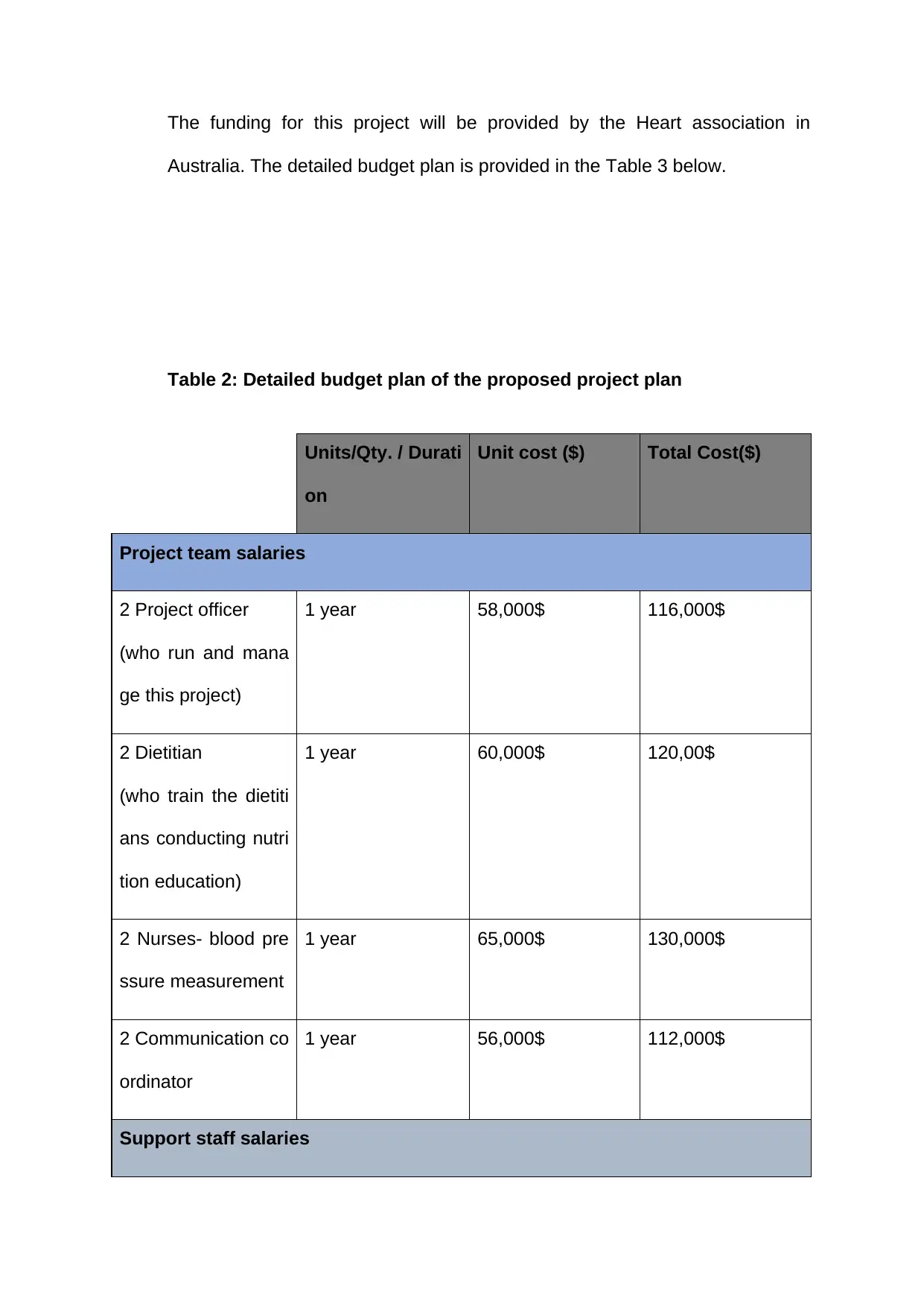
The funding for this project will be provided by the Heart association in
Australia. The detailed budget plan is provided in the Table 3 below.
Table 2: Detailed budget plan of the proposed project plan
Units/Qty. / Durati
on
Unit cost ($) Total Cost($)
Project team salaries
2 Project officer
(who run and mana
ge this project)
1 year 58,000$ 116,000$
2 Dietitian
(who train the dietiti
ans conducting nutri
tion education)
1 year 60,000$ 120,00$
2 Nurses- blood pre
ssure measurement
1 year 65,000$ 130,000$
2 Communication co
ordinator
1 year 56,000$ 112,000$
Support staff salaries
Australia. The detailed budget plan is provided in the Table 3 below.
Table 2: Detailed budget plan of the proposed project plan
Units/Qty. / Durati
on
Unit cost ($) Total Cost($)
Project team salaries
2 Project officer
(who run and mana
ge this project)
1 year 58,000$ 116,000$
2 Dietitian
(who train the dietiti
ans conducting nutri
tion education)
1 year 60,000$ 120,00$
2 Nurses- blood pre
ssure measurement
1 year 65,000$ 130,000$
2 Communication co
ordinator
1 year 56,000$ 112,000$
Support staff salaries
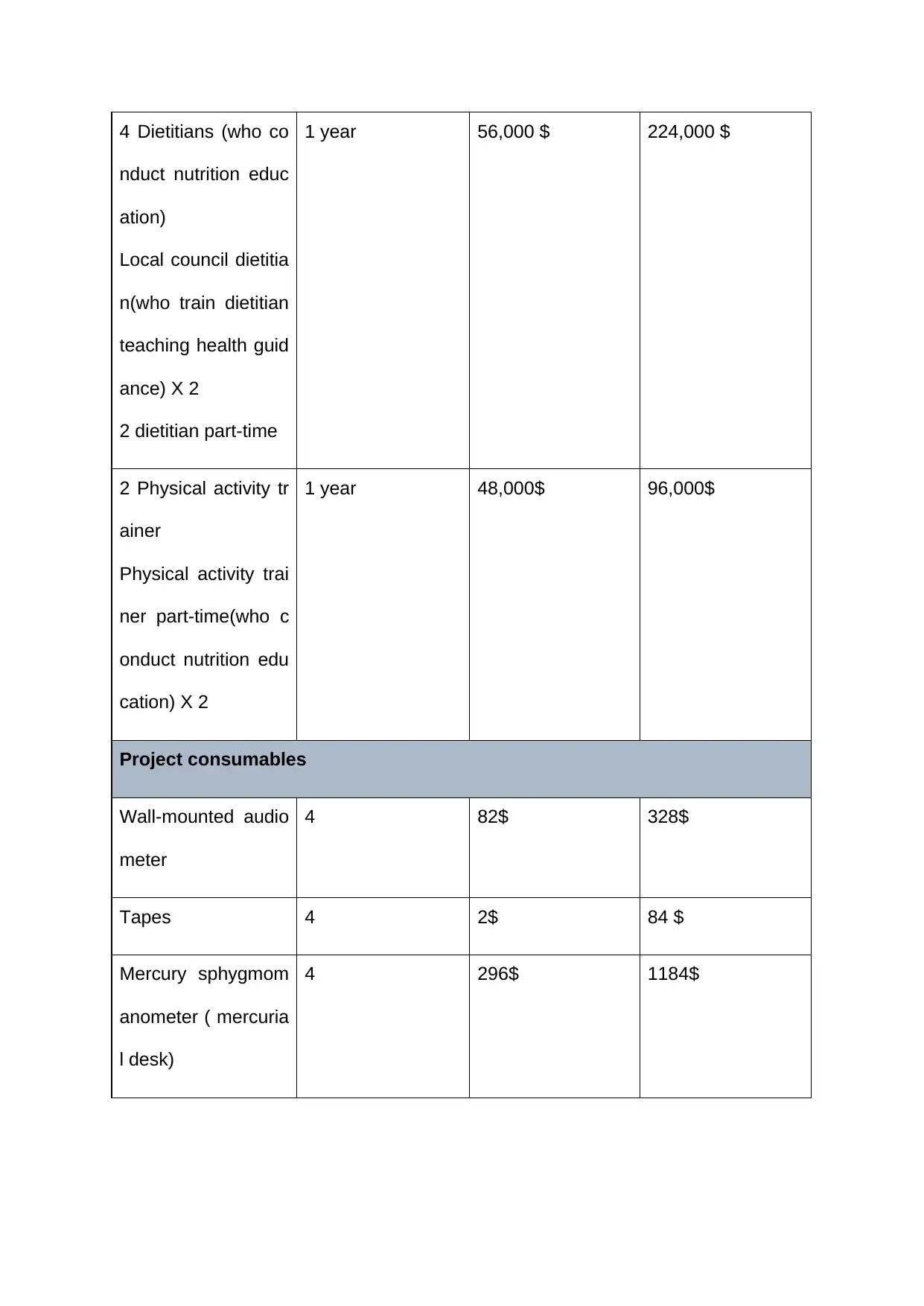
4 Dietitians (who co
nduct nutrition educ
ation)
Local council dietitia
n(who train dietitian
teaching health guid
ance) X 2
2 dietitian part-time
1 year 56,000 $ 224,000 $
2 Physical activity tr
ainer
Physical activity trai
ner part-time(who c
onduct nutrition edu
cation) X 2
1 year 48,000$ 96,000$
Project consumables
Wall-mounted audio
meter
4 82$ 328$
Tapes 4 2$ 84 $
Mercury sphygmom
anometer ( mercuria
l desk)
4 296$ 1184$
nduct nutrition educ
ation)
Local council dietitia
n(who train dietitian
teaching health guid
ance) X 2
2 dietitian part-time
1 year 56,000 $ 224,000 $
2 Physical activity tr
ainer
Physical activity trai
ner part-time(who c
onduct nutrition edu
cation) X 2
1 year 48,000$ 96,000$
Project consumables
Wall-mounted audio
meter
4 82$ 328$
Tapes 4 2$ 84 $
Mercury sphygmom
anometer ( mercuria
l desk)
4 296$ 1184$
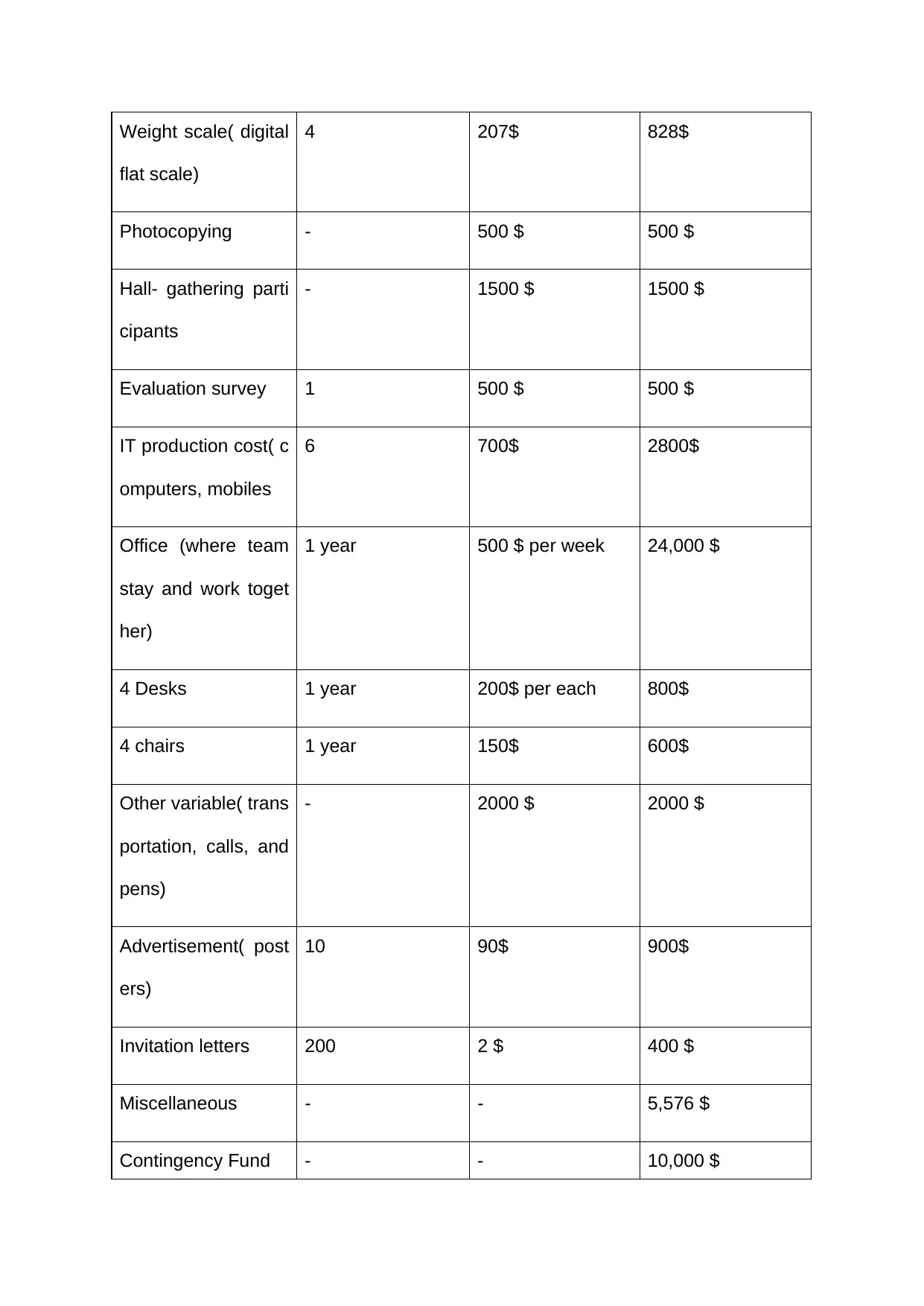
Weight scale( digital
flat scale)
4 207$ 828$
Photocopying - 500 $ 500 $
Hall- gathering parti
cipants
- 1500 $ 1500 $
Evaluation survey 1 500 $ 500 $
IT production cost( c
omputers, mobiles
6 700$ 2800$
Office (where team
stay and work toget
her)
1 year 500 $ per week 24,000 $
4 Desks 1 year 200$ per each 800$
4 chairs 1 year 150$ 600$
Other variable( trans
portation, calls, and
pens)
- 2000 $ 2000 $
Advertisement( post
ers)
10 90$ 900$
Invitation letters 200 2 $ 400 $
Miscellaneous - - 5,576 $
Contingency Fund - - 10,000 $
flat scale)
4 207$ 828$
Photocopying - 500 $ 500 $
Hall- gathering parti
cipants
- 1500 $ 1500 $
Evaluation survey 1 500 $ 500 $
IT production cost( c
omputers, mobiles
6 700$ 2800$
Office (where team
stay and work toget
her)
1 year 500 $ per week 24,000 $
4 Desks 1 year 200$ per each 800$
4 chairs 1 year 150$ 600$
Other variable( trans
portation, calls, and
pens)
- 2000 $ 2000 $
Advertisement( post
ers)
10 90$ 900$
Invitation letters 200 2 $ 400 $
Miscellaneous - - 5,576 $
Contingency Fund - - 10,000 $
Paraphrase This Document
Need a fresh take? Get an instant paraphrase of this document with our AI Paraphraser
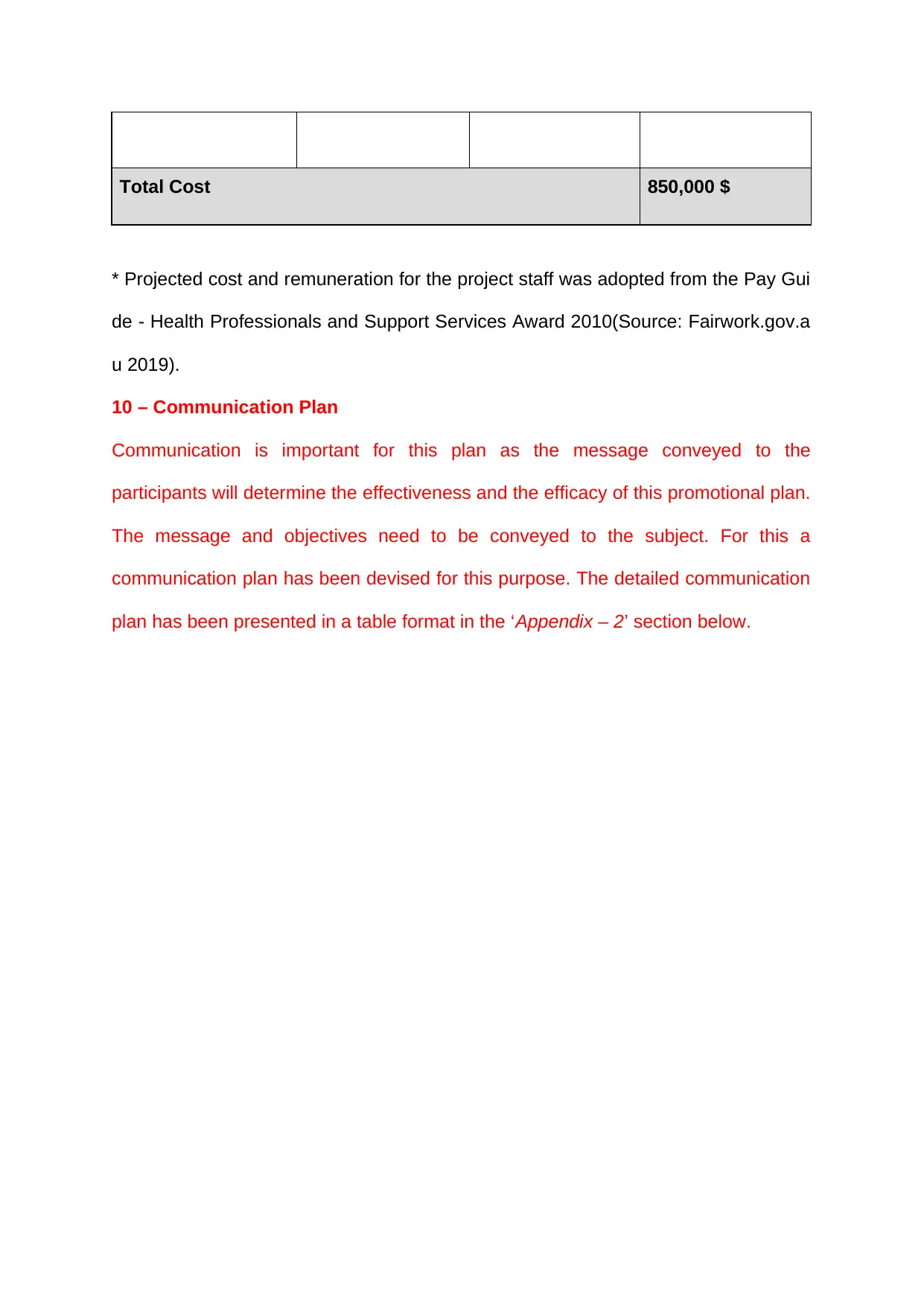
Total Cost 850,000 $
* Projected cost and remuneration for the project staff was adopted from the Pay Gui
de - Health Professionals and Support Services Award 2010(Source: Fairwork.gov.a
u 2019).
10 – Communication Plan
Communication is important for this plan as the message conveyed to the
participants will determine the effectiveness and the efficacy of this promotional plan.
The message and objectives need to be conveyed to the subject. For this a
communication plan has been devised for this purpose. The detailed communication
plan has been presented in a table format in the ‘Appendix – 2’ section below.
* Projected cost and remuneration for the project staff was adopted from the Pay Gui
de - Health Professionals and Support Services Award 2010(Source: Fairwork.gov.a
u 2019).
10 – Communication Plan
Communication is important for this plan as the message conveyed to the
participants will determine the effectiveness and the efficacy of this promotional plan.
The message and objectives need to be conveyed to the subject. For this a
communication plan has been devised for this purpose. The detailed communication
plan has been presented in a table format in the ‘Appendix – 2’ section below.

11- References:
Abs.gov.au 2019. 4364.0.55.001 - National Health Survey: First Results, 2017-18.
Abs.gov.au. Available at :https://www.abs.gov.au/ausstats/abs@.nsf/Lookup/by
%20Subject/4364.0.55.001~2017-18~Main%20Features~Hypertension%20and
%20measured%20high%20blood%20pressure~60 [Accessed 15 May 2019].
Ashwell, M. and Gibson, S., 2016. Waist-to-height ratio as an indicator of ‘early
health risk’: simpler and more predictive than using a ‘matrix’ based on BMI and
waist circumference. BMJ open, 6(3), p.e010159.
Australian Bureau of Statistics. 2015. National Health Survey, Australia 2014-2015.
pp. 17-18.
Burke V, Giangiulio N, Gillam HF, Beilin LJ, Houghton S, Milli- gan RAK. Health
promotion in couples adapting to a shared life- style. Health Educ Res 1999; 14:
269–288.
Burke, V., Mori, T.A., Giangiulio, N., Gillam, H.F., Beilin, L.J., Houghton, S., Cutt,
H.E., Mansour, J. and Wilson, A., 2002. An innovative program for changing health
behaviours. Asia Pacific Journal of Clinical Nutrition, vol.11, pp.S586-S597.
Burks, M., Stickel, S. and Galie, N., 2018. Pulmonary arterial hypertension:
combination therapy in practice. American Journal of Cardiovascular Drugs, 18(4),
pp.249-257.
Buscot, M.J., Thomson, R.J., Juonala, M., Sabin, M.A., Burgner, D.P., Lehtimäki, T.,
Hutri-Kähönen, N., Viikari, J.S., Jokinen, E., Tossavainen, P. and Laitinen, T., 2018.
BMI trajectories associated with resolution of elevated youth BMI and incident adult
obesity. Pediatrics, 141(1), p.e20172003.
Coca, A., Agabiti-Rosei, E., Cifkova, R., Manolis, A.J., Redón, J. and Mancia, G.,
2017. The polypill in cardiovascular prevention: evidence, limitations and
Abs.gov.au 2019. 4364.0.55.001 - National Health Survey: First Results, 2017-18.
Abs.gov.au. Available at :https://www.abs.gov.au/ausstats/abs@.nsf/Lookup/by
%20Subject/4364.0.55.001~2017-18~Main%20Features~Hypertension%20and
%20measured%20high%20blood%20pressure~60 [Accessed 15 May 2019].
Ashwell, M. and Gibson, S., 2016. Waist-to-height ratio as an indicator of ‘early
health risk’: simpler and more predictive than using a ‘matrix’ based on BMI and
waist circumference. BMJ open, 6(3), p.e010159.
Australian Bureau of Statistics. 2015. National Health Survey, Australia 2014-2015.
pp. 17-18.
Burke V, Giangiulio N, Gillam HF, Beilin LJ, Houghton S, Milli- gan RAK. Health
promotion in couples adapting to a shared life- style. Health Educ Res 1999; 14:
269–288.
Burke, V., Mori, T.A., Giangiulio, N., Gillam, H.F., Beilin, L.J., Houghton, S., Cutt,
H.E., Mansour, J. and Wilson, A., 2002. An innovative program for changing health
behaviours. Asia Pacific Journal of Clinical Nutrition, vol.11, pp.S586-S597.
Burks, M., Stickel, S. and Galie, N., 2018. Pulmonary arterial hypertension:
combination therapy in practice. American Journal of Cardiovascular Drugs, 18(4),
pp.249-257.
Buscot, M.J., Thomson, R.J., Juonala, M., Sabin, M.A., Burgner, D.P., Lehtimäki, T.,
Hutri-Kähönen, N., Viikari, J.S., Jokinen, E., Tossavainen, P. and Laitinen, T., 2018.
BMI trajectories associated with resolution of elevated youth BMI and incident adult
obesity. Pediatrics, 141(1), p.e20172003.
Coca, A., Agabiti-Rosei, E., Cifkova, R., Manolis, A.J., Redón, J. and Mancia, G.,
2017. The polypill in cardiovascular prevention: evidence, limitations and
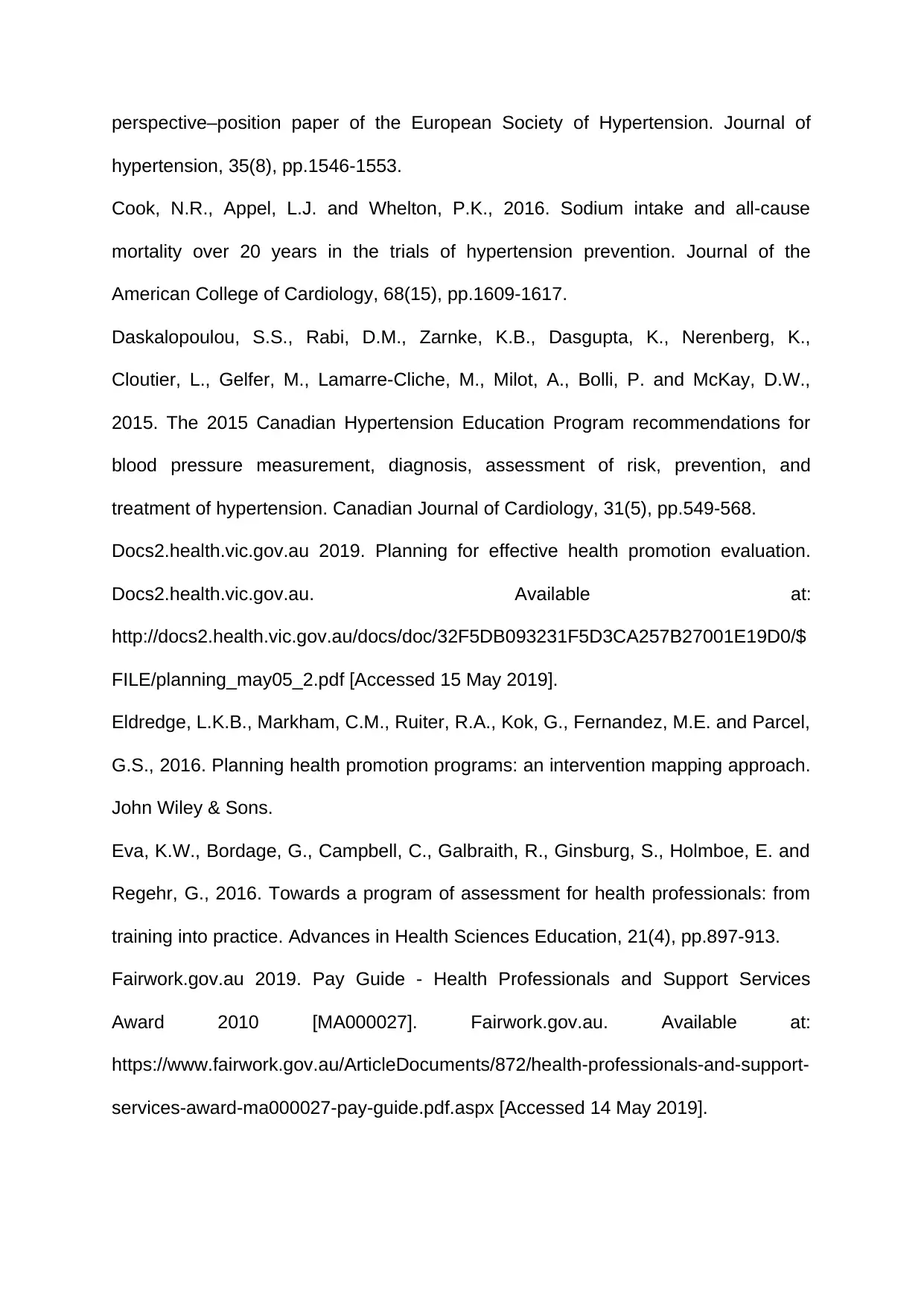
perspective–position paper of the European Society of Hypertension. Journal of
hypertension, 35(8), pp.1546-1553.
Cook, N.R., Appel, L.J. and Whelton, P.K., 2016. Sodium intake and all-cause
mortality over 20 years in the trials of hypertension prevention. Journal of the
American College of Cardiology, 68(15), pp.1609-1617.
Daskalopoulou, S.S., Rabi, D.M., Zarnke, K.B., Dasgupta, K., Nerenberg, K.,
Cloutier, L., Gelfer, M., Lamarre-Cliche, M., Milot, A., Bolli, P. and McKay, D.W.,
2015. The 2015 Canadian Hypertension Education Program recommendations for
blood pressure measurement, diagnosis, assessment of risk, prevention, and
treatment of hypertension. Canadian Journal of Cardiology, 31(5), pp.549-568.
Docs2.health.vic.gov.au 2019. Planning for effective health promotion evaluation.
Docs2.health.vic.gov.au. Available at:
http://docs2.health.vic.gov.au/docs/doc/32F5DB093231F5D3CA257B27001E19D0/$
FILE/planning_may05_2.pdf [Accessed 15 May 2019].
Eldredge, L.K.B., Markham, C.M., Ruiter, R.A., Kok, G., Fernandez, M.E. and Parcel,
G.S., 2016. Planning health promotion programs: an intervention mapping approach.
John Wiley & Sons.
Eva, K.W., Bordage, G., Campbell, C., Galbraith, R., Ginsburg, S., Holmboe, E. and
Regehr, G., 2016. Towards a program of assessment for health professionals: from
training into practice. Advances in Health Sciences Education, 21(4), pp.897-913.
Fairwork.gov.au 2019. Pay Guide - Health Professionals and Support Services
Award 2010 [MA000027]. Fairwork.gov.au. Available at:
https://www.fairwork.gov.au/ArticleDocuments/872/health-professionals-and-support-
services-award-ma000027-pay-guide.pdf.aspx [Accessed 14 May 2019].
hypertension, 35(8), pp.1546-1553.
Cook, N.R., Appel, L.J. and Whelton, P.K., 2016. Sodium intake and all-cause
mortality over 20 years in the trials of hypertension prevention. Journal of the
American College of Cardiology, 68(15), pp.1609-1617.
Daskalopoulou, S.S., Rabi, D.M., Zarnke, K.B., Dasgupta, K., Nerenberg, K.,
Cloutier, L., Gelfer, M., Lamarre-Cliche, M., Milot, A., Bolli, P. and McKay, D.W.,
2015. The 2015 Canadian Hypertension Education Program recommendations for
blood pressure measurement, diagnosis, assessment of risk, prevention, and
treatment of hypertension. Canadian Journal of Cardiology, 31(5), pp.549-568.
Docs2.health.vic.gov.au 2019. Planning for effective health promotion evaluation.
Docs2.health.vic.gov.au. Available at:
http://docs2.health.vic.gov.au/docs/doc/32F5DB093231F5D3CA257B27001E19D0/$
FILE/planning_may05_2.pdf [Accessed 15 May 2019].
Eldredge, L.K.B., Markham, C.M., Ruiter, R.A., Kok, G., Fernandez, M.E. and Parcel,
G.S., 2016. Planning health promotion programs: an intervention mapping approach.
John Wiley & Sons.
Eva, K.W., Bordage, G., Campbell, C., Galbraith, R., Ginsburg, S., Holmboe, E. and
Regehr, G., 2016. Towards a program of assessment for health professionals: from
training into practice. Advances in Health Sciences Education, 21(4), pp.897-913.
Fairwork.gov.au 2019. Pay Guide - Health Professionals and Support Services
Award 2010 [MA000027]. Fairwork.gov.au. Available at:
https://www.fairwork.gov.au/ArticleDocuments/872/health-professionals-and-support-
services-award-ma000027-pay-guide.pdf.aspx [Accessed 14 May 2019].
Secure Best Marks with AI Grader
Need help grading? Try our AI Grader for instant feedback on your assignments.
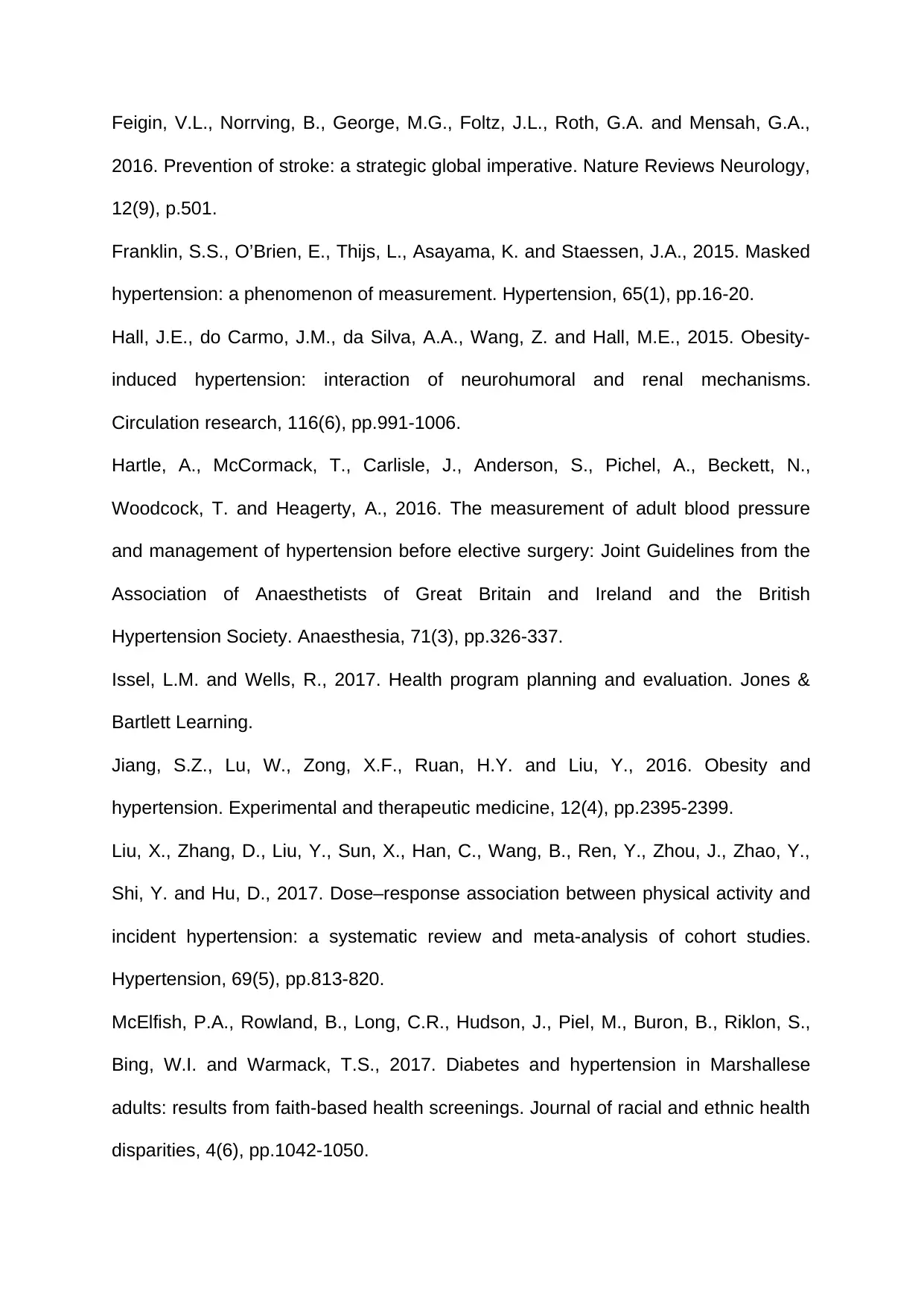
Feigin, V.L., Norrving, B., George, M.G., Foltz, J.L., Roth, G.A. and Mensah, G.A.,
2016. Prevention of stroke: a strategic global imperative. Nature Reviews Neurology,
12(9), p.501.
Franklin, S.S., O’Brien, E., Thijs, L., Asayama, K. and Staessen, J.A., 2015. Masked
hypertension: a phenomenon of measurement. Hypertension, 65(1), pp.16-20.
Hall, J.E., do Carmo, J.M., da Silva, A.A., Wang, Z. and Hall, M.E., 2015. Obesity-
induced hypertension: interaction of neurohumoral and renal mechanisms.
Circulation research, 116(6), pp.991-1006.
Hartle, A., McCormack, T., Carlisle, J., Anderson, S., Pichel, A., Beckett, N.,
Woodcock, T. and Heagerty, A., 2016. The measurement of adult blood pressure
and management of hypertension before elective surgery: Joint Guidelines from the
Association of Anaesthetists of Great Britain and Ireland and the British
Hypertension Society. Anaesthesia, 71(3), pp.326-337.
Issel, L.M. and Wells, R., 2017. Health program planning and evaluation. Jones &
Bartlett Learning.
Jiang, S.Z., Lu, W., Zong, X.F., Ruan, H.Y. and Liu, Y., 2016. Obesity and
hypertension. Experimental and therapeutic medicine, 12(4), pp.2395-2399.
Liu, X., Zhang, D., Liu, Y., Sun, X., Han, C., Wang, B., Ren, Y., Zhou, J., Zhao, Y.,
Shi, Y. and Hu, D., 2017. Dose–response association between physical activity and
incident hypertension: a systematic review and meta-analysis of cohort studies.
Hypertension, 69(5), pp.813-820.
McElfish, P.A., Rowland, B., Long, C.R., Hudson, J., Piel, M., Buron, B., Riklon, S.,
Bing, W.I. and Warmack, T.S., 2017. Diabetes and hypertension in Marshallese
adults: results from faith-based health screenings. Journal of racial and ethnic health
disparities, 4(6), pp.1042-1050.
2016. Prevention of stroke: a strategic global imperative. Nature Reviews Neurology,
12(9), p.501.
Franklin, S.S., O’Brien, E., Thijs, L., Asayama, K. and Staessen, J.A., 2015. Masked
hypertension: a phenomenon of measurement. Hypertension, 65(1), pp.16-20.
Hall, J.E., do Carmo, J.M., da Silva, A.A., Wang, Z. and Hall, M.E., 2015. Obesity-
induced hypertension: interaction of neurohumoral and renal mechanisms.
Circulation research, 116(6), pp.991-1006.
Hartle, A., McCormack, T., Carlisle, J., Anderson, S., Pichel, A., Beckett, N.,
Woodcock, T. and Heagerty, A., 2016. The measurement of adult blood pressure
and management of hypertension before elective surgery: Joint Guidelines from the
Association of Anaesthetists of Great Britain and Ireland and the British
Hypertension Society. Anaesthesia, 71(3), pp.326-337.
Issel, L.M. and Wells, R., 2017. Health program planning and evaluation. Jones &
Bartlett Learning.
Jiang, S.Z., Lu, W., Zong, X.F., Ruan, H.Y. and Liu, Y., 2016. Obesity and
hypertension. Experimental and therapeutic medicine, 12(4), pp.2395-2399.
Liu, X., Zhang, D., Liu, Y., Sun, X., Han, C., Wang, B., Ren, Y., Zhou, J., Zhao, Y.,
Shi, Y. and Hu, D., 2017. Dose–response association between physical activity and
incident hypertension: a systematic review and meta-analysis of cohort studies.
Hypertension, 69(5), pp.813-820.
McElfish, P.A., Rowland, B., Long, C.R., Hudson, J., Piel, M., Buron, B., Riklon, S.,
Bing, W.I. and Warmack, T.S., 2017. Diabetes and hypertension in Marshallese
adults: results from faith-based health screenings. Journal of racial and ethnic health
disparities, 4(6), pp.1042-1050.
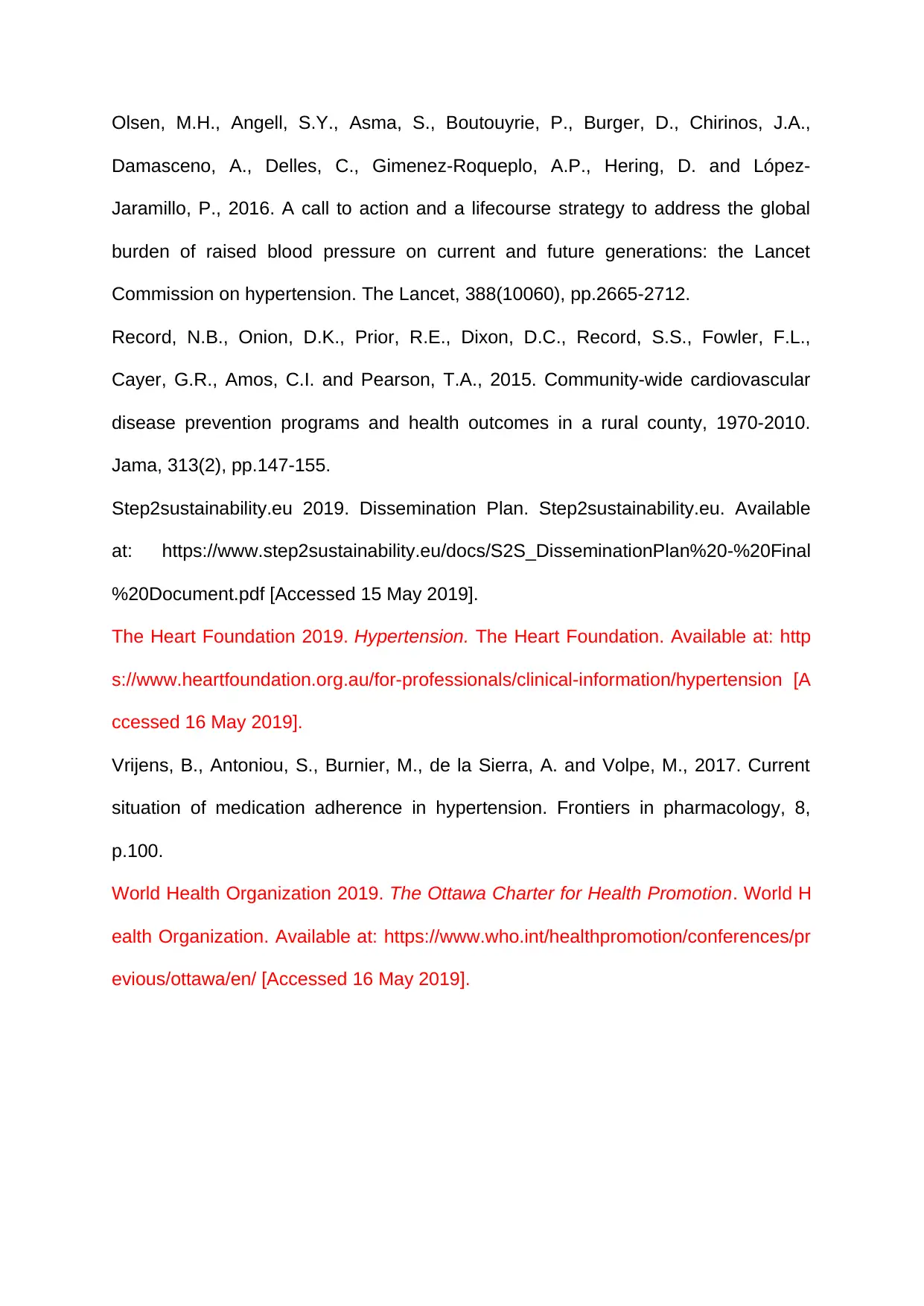
Olsen, M.H., Angell, S.Y., Asma, S., Boutouyrie, P., Burger, D., Chirinos, J.A.,
Damasceno, A., Delles, C., Gimenez-Roqueplo, A.P., Hering, D. and López-
Jaramillo, P., 2016. A call to action and a lifecourse strategy to address the global
burden of raised blood pressure on current and future generations: the Lancet
Commission on hypertension. The Lancet, 388(10060), pp.2665-2712.
Record, N.B., Onion, D.K., Prior, R.E., Dixon, D.C., Record, S.S., Fowler, F.L.,
Cayer, G.R., Amos, C.I. and Pearson, T.A., 2015. Community-wide cardiovascular
disease prevention programs and health outcomes in a rural county, 1970-2010.
Jama, 313(2), pp.147-155.
Step2sustainability.eu 2019. Dissemination Plan. Step2sustainability.eu. Available
at: https://www.step2sustainability.eu/docs/S2S_DisseminationPlan%20-%20Final
%20Document.pdf [Accessed 15 May 2019].
The Heart Foundation 2019. Hypertension. The Heart Foundation. Available at: http
s://www.heartfoundation.org.au/for-professionals/clinical-information/hypertension [A
ccessed 16 May 2019].
Vrijens, B., Antoniou, S., Burnier, M., de la Sierra, A. and Volpe, M., 2017. Current
situation of medication adherence in hypertension. Frontiers in pharmacology, 8,
p.100.
World Health Organization 2019. The Ottawa Charter for Health Promotion. World H
ealth Organization. Available at: https://www.who.int/healthpromotion/conferences/pr
evious/ottawa/en/ [Accessed 16 May 2019].
Damasceno, A., Delles, C., Gimenez-Roqueplo, A.P., Hering, D. and López-
Jaramillo, P., 2016. A call to action and a lifecourse strategy to address the global
burden of raised blood pressure on current and future generations: the Lancet
Commission on hypertension. The Lancet, 388(10060), pp.2665-2712.
Record, N.B., Onion, D.K., Prior, R.E., Dixon, D.C., Record, S.S., Fowler, F.L.,
Cayer, G.R., Amos, C.I. and Pearson, T.A., 2015. Community-wide cardiovascular
disease prevention programs and health outcomes in a rural county, 1970-2010.
Jama, 313(2), pp.147-155.
Step2sustainability.eu 2019. Dissemination Plan. Step2sustainability.eu. Available
at: https://www.step2sustainability.eu/docs/S2S_DisseminationPlan%20-%20Final
%20Document.pdf [Accessed 15 May 2019].
The Heart Foundation 2019. Hypertension. The Heart Foundation. Available at: http
s://www.heartfoundation.org.au/for-professionals/clinical-information/hypertension [A
ccessed 16 May 2019].
Vrijens, B., Antoniou, S., Burnier, M., de la Sierra, A. and Volpe, M., 2017. Current
situation of medication adherence in hypertension. Frontiers in pharmacology, 8,
p.100.
World Health Organization 2019. The Ottawa Charter for Health Promotion. World H
ealth Organization. Available at: https://www.who.int/healthpromotion/conferences/pr
evious/ottawa/en/ [Accessed 16 May 2019].
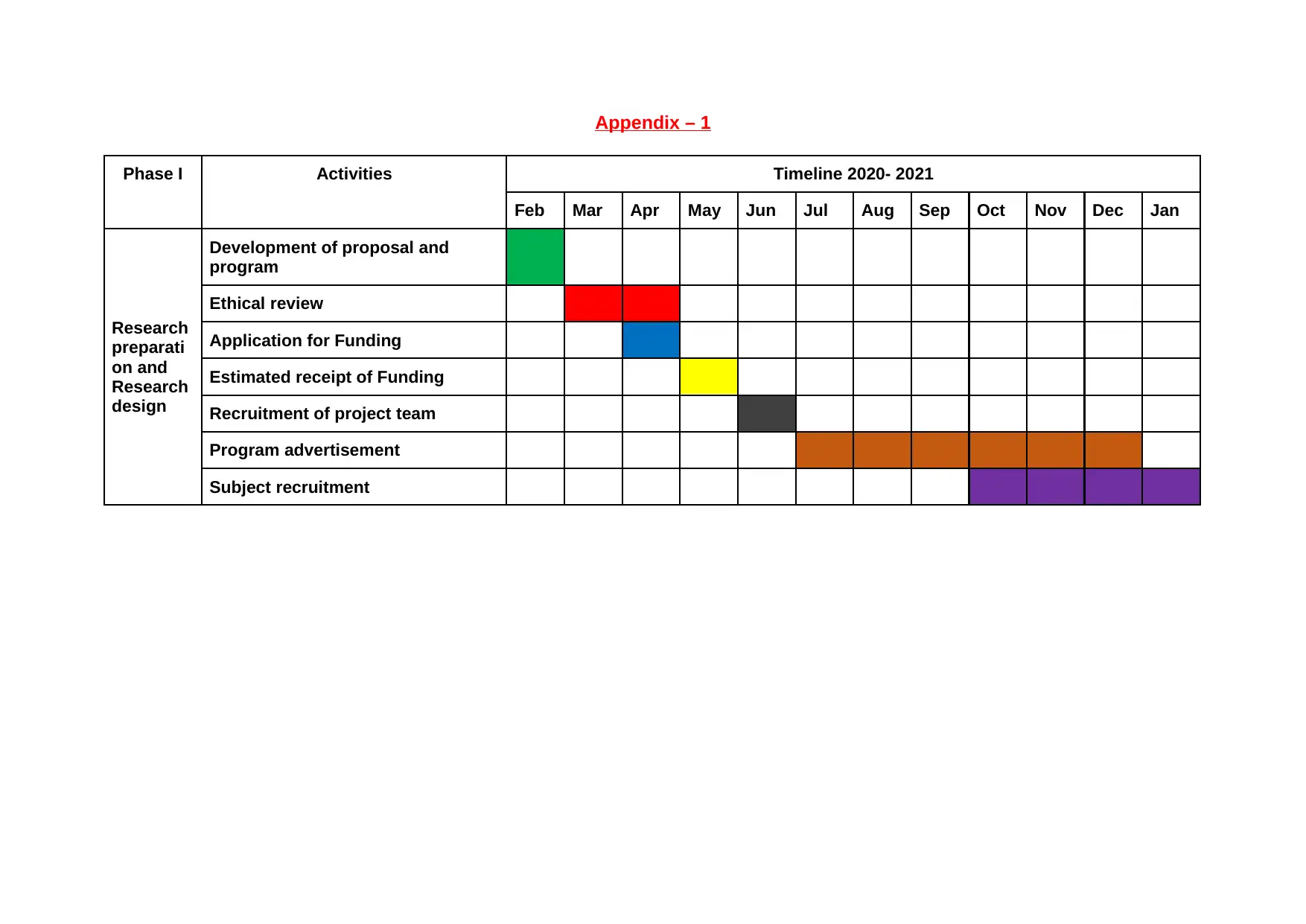
Appendix – 1
Phase I Activities Timeline 2020- 2021
Feb Mar Apr May Jun Jul Aug Sep Oct Nov Dec Jan
Research
preparati
on and
Research
design
Development of proposal and
program
Ethical review
Application for Funding
Estimated receipt of Funding
Recruitment of project team
Program advertisement
Subject recruitment
Phase I Activities Timeline 2020- 2021
Feb Mar Apr May Jun Jul Aug Sep Oct Nov Dec Jan
Research
preparati
on and
Research
design
Development of proposal and
program
Ethical review
Application for Funding
Estimated receipt of Funding
Recruitment of project team
Program advertisement
Subject recruitment
Paraphrase This Document
Need a fresh take? Get an instant paraphrase of this document with our AI Paraphraser
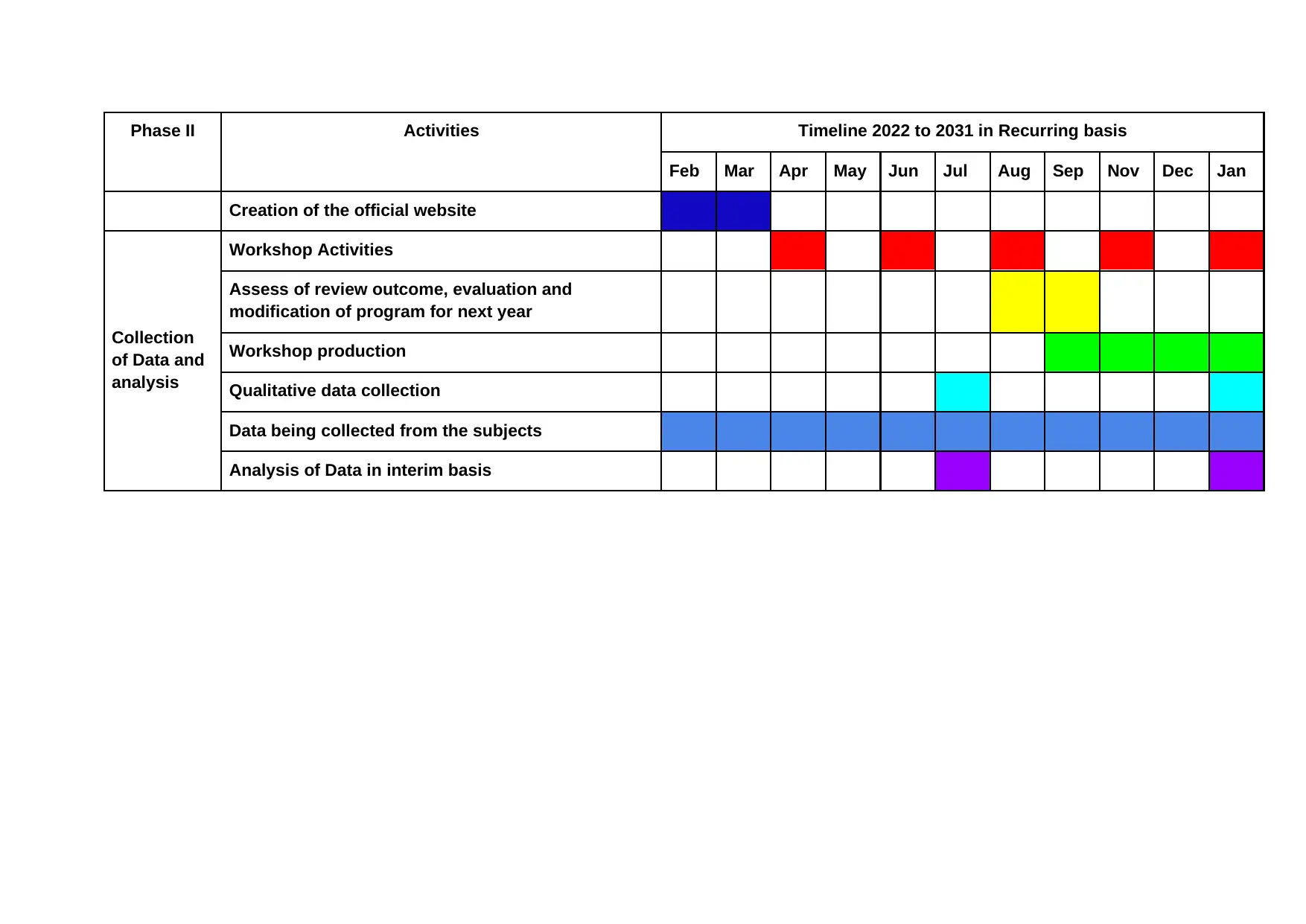
Phase II Activities Timeline 2022 to 2031 in Recurring basis
Feb Mar Apr May Jun Jul Aug Sep Nov Dec Jan
Creation of the official website
Collection
of Data and
analysis
Workshop Activities
Assess of review outcome, evaluation and
modification of program for next year
Workshop production
Qualitative data collection
Data being collected from the subjects
Analysis of Data in interim basis
Feb Mar Apr May Jun Jul Aug Sep Nov Dec Jan
Creation of the official website
Collection
of Data and
analysis
Workshop Activities
Assess of review outcome, evaluation and
modification of program for next year
Workshop production
Qualitative data collection
Data being collected from the subjects
Analysis of Data in interim basis
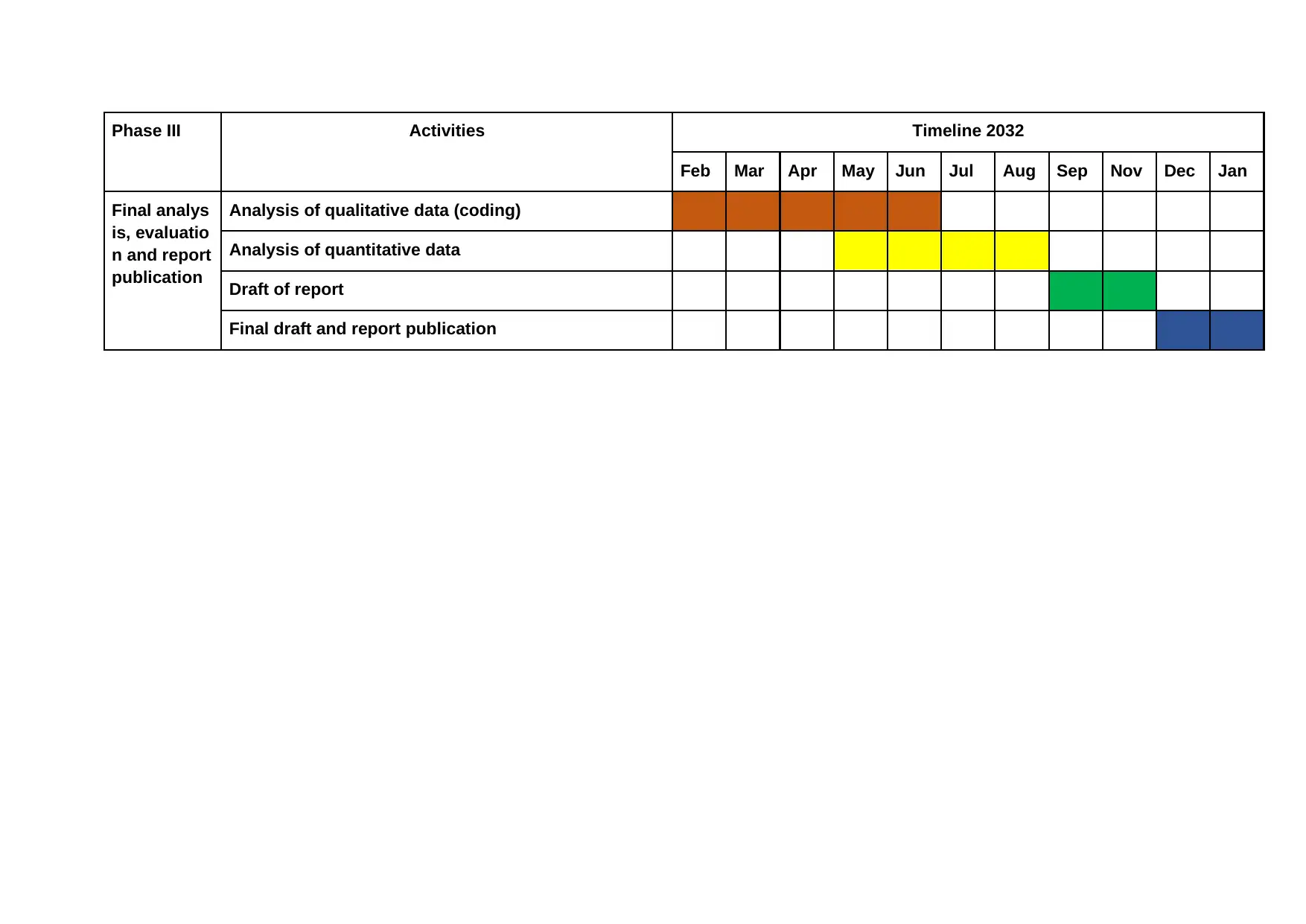
Phase III Activities Timeline 2032
Feb Mar Apr May Jun Jul Aug Sep Nov Dec Jan
Final analys
is, evaluatio
n and report
publication
Analysis of qualitative data (coding)
Analysis of quantitative data
Draft of report
Final draft and report publication
Feb Mar Apr May Jun Jul Aug Sep Nov Dec Jan
Final analys
is, evaluatio
n and report
publication
Analysis of qualitative data (coding)
Analysis of quantitative data
Draft of report
Final draft and report publication
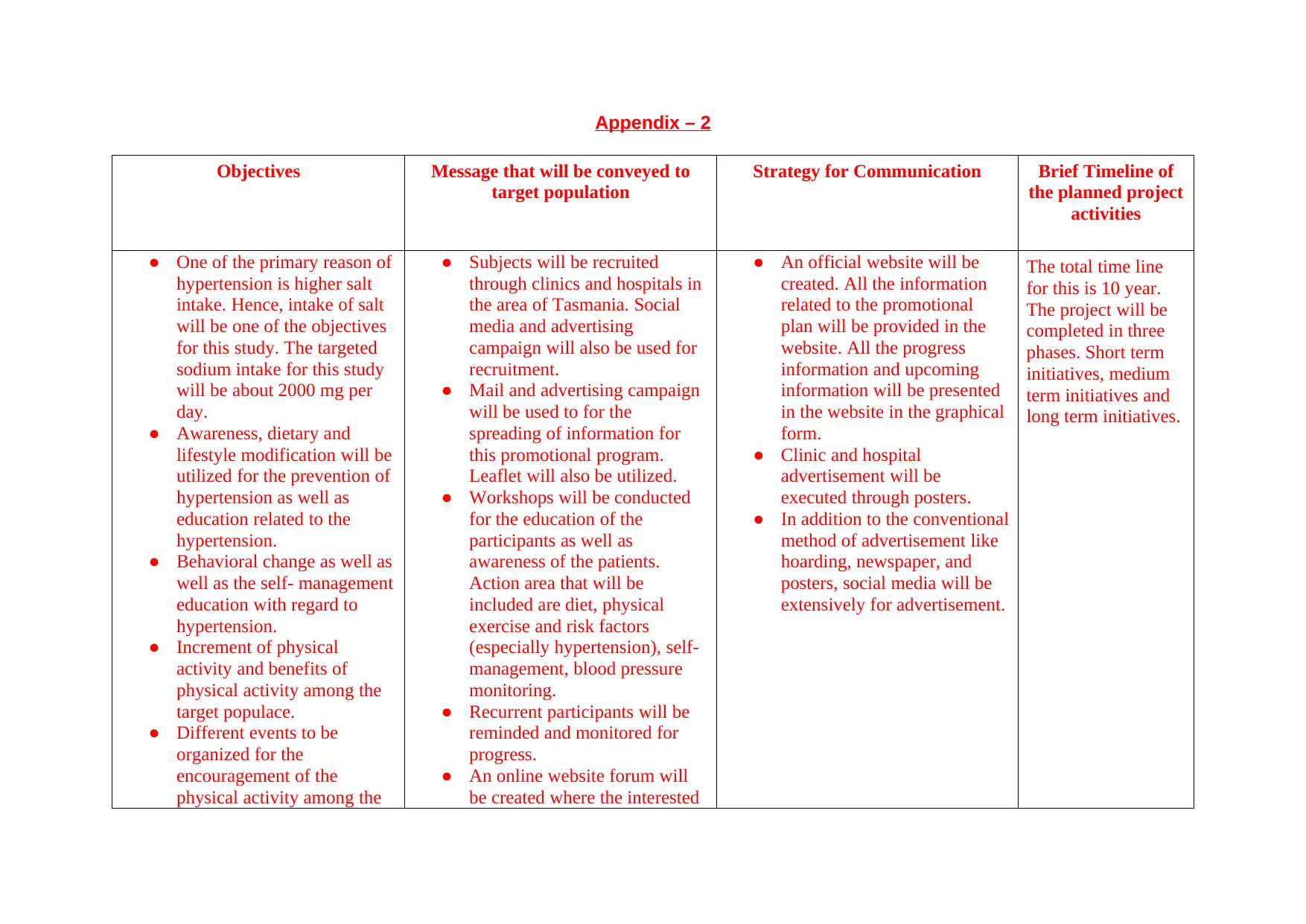
Appendix – 2
Objectives Message that will be conveyed to
target population
Strategy for Communication Brief Timeline of
the planned project
activities
● One of the primary reason of
hypertension is higher salt
intake. Hence, intake of salt
will be one of the objectives
for this study. The targeted
sodium intake for this study
will be about 2000 mg per
day.
● Awareness, dietary and
lifestyle modification will be
utilized for the prevention of
hypertension as well as
education related to the
hypertension.
● Behavioral change as well as
well as the self- management
education with regard to
hypertension.
● Increment of physical
activity and benefits of
physical activity among the
target populace.
● Different events to be
organized for the
encouragement of the
physical activity among the
● Subjects will be recruited
through clinics and hospitals in
the area of Tasmania. Social
media and advertising
campaign will also be used for
recruitment.
● Mail and advertising campaign
will be used to for the
spreading of information for
this promotional program.
Leaflet will also be utilized.
● Workshops will be conducted
for the education of the
participants as well as
awareness of the patients.
Action area that will be
included are diet, physical
exercise and risk factors
(especially hypertension), self-
management, blood pressure
monitoring.
● Recurrent participants will be
reminded and monitored for
progress.
● An online website forum will
be created where the interested
● An official website will be
created. All the information
related to the promotional
plan will be provided in the
website. All the progress
information and upcoming
information will be presented
in the website in the graphical
form.
● Clinic and hospital
advertisement will be
executed through posters.
● In addition to the conventional
method of advertisement like
hoarding, newspaper, and
posters, social media will be
extensively for advertisement.
The total time line
for this is 10 year.
The project will be
completed in three
phases. Short term
initiatives, medium
term initiatives and
long term initiatives.
Objectives Message that will be conveyed to
target population
Strategy for Communication Brief Timeline of
the planned project
activities
● One of the primary reason of
hypertension is higher salt
intake. Hence, intake of salt
will be one of the objectives
for this study. The targeted
sodium intake for this study
will be about 2000 mg per
day.
● Awareness, dietary and
lifestyle modification will be
utilized for the prevention of
hypertension as well as
education related to the
hypertension.
● Behavioral change as well as
well as the self- management
education with regard to
hypertension.
● Increment of physical
activity and benefits of
physical activity among the
target populace.
● Different events to be
organized for the
encouragement of the
physical activity among the
● Subjects will be recruited
through clinics and hospitals in
the area of Tasmania. Social
media and advertising
campaign will also be used for
recruitment.
● Mail and advertising campaign
will be used to for the
spreading of information for
this promotional program.
Leaflet will also be utilized.
● Workshops will be conducted
for the education of the
participants as well as
awareness of the patients.
Action area that will be
included are diet, physical
exercise and risk factors
(especially hypertension), self-
management, blood pressure
monitoring.
● Recurrent participants will be
reminded and monitored for
progress.
● An online website forum will
be created where the interested
● An official website will be
created. All the information
related to the promotional
plan will be provided in the
website. All the progress
information and upcoming
information will be presented
in the website in the graphical
form.
● Clinic and hospital
advertisement will be
executed through posters.
● In addition to the conventional
method of advertisement like
hoarding, newspaper, and
posters, social media will be
extensively for advertisement.
The total time line
for this is 10 year.
The project will be
completed in three
phases. Short term
initiatives, medium
term initiatives and
long term initiatives.
Secure Best Marks with AI Grader
Need help grading? Try our AI Grader for instant feedback on your assignments.
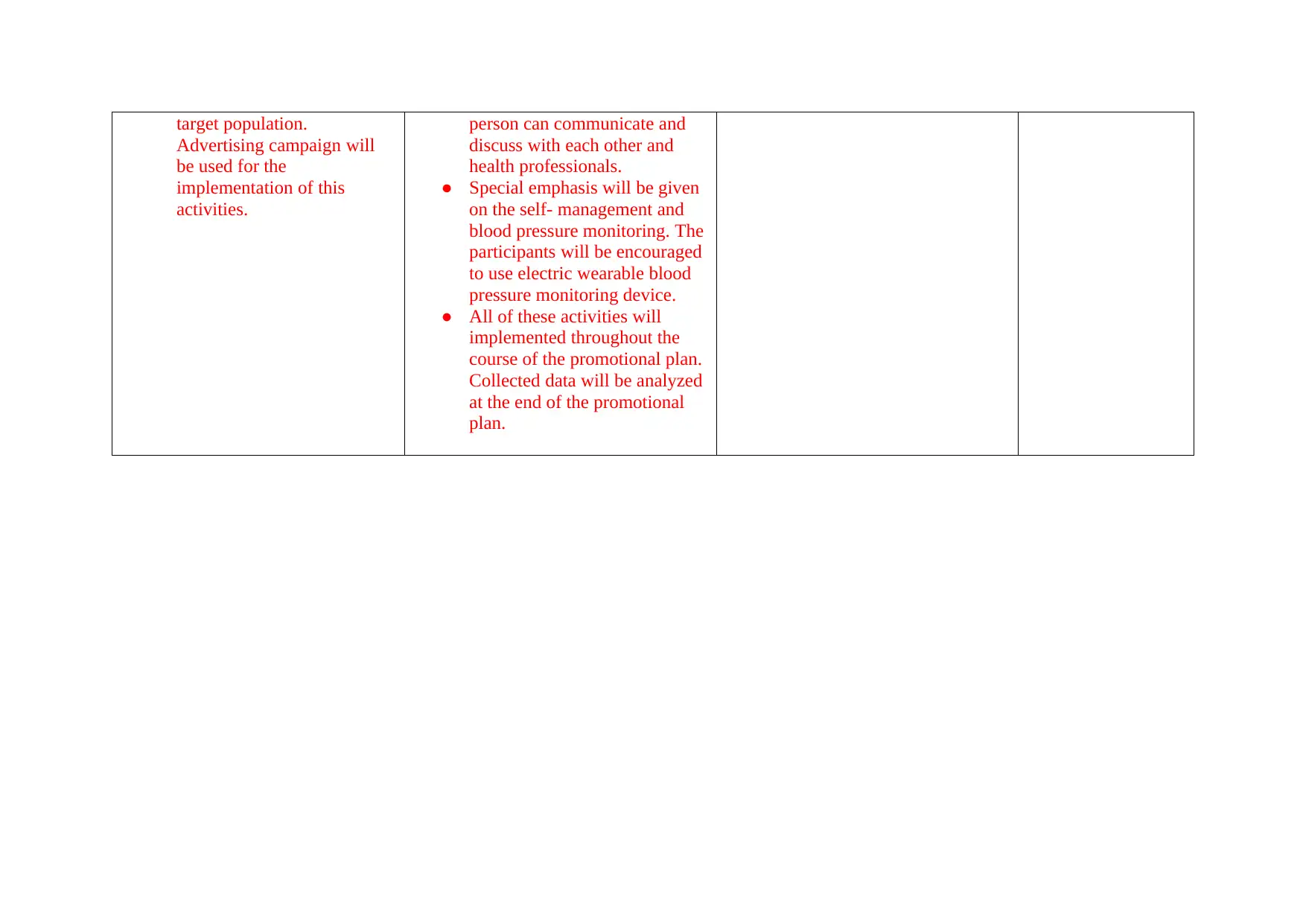
target population.
Advertising campaign will
be used for the
implementation of this
activities.
person can communicate and
discuss with each other and
health professionals.
● Special emphasis will be given
on the self- management and
blood pressure monitoring. The
participants will be encouraged
to use electric wearable blood
pressure monitoring device.
● All of these activities will
implemented throughout the
course of the promotional plan.
Collected data will be analyzed
at the end of the promotional
plan.
Advertising campaign will
be used for the
implementation of this
activities.
person can communicate and
discuss with each other and
health professionals.
● Special emphasis will be given
on the self- management and
blood pressure monitoring. The
participants will be encouraged
to use electric wearable blood
pressure monitoring device.
● All of these activities will
implemented throughout the
course of the promotional plan.
Collected data will be analyzed
at the end of the promotional
plan.
1 out of 26
Your All-in-One AI-Powered Toolkit for Academic Success.
+13062052269
info@desklib.com
Available 24*7 on WhatsApp / Email
![[object Object]](/_next/static/media/star-bottom.7253800d.svg)
Unlock your academic potential
© 2024 | Zucol Services PVT LTD | All rights reserved.





